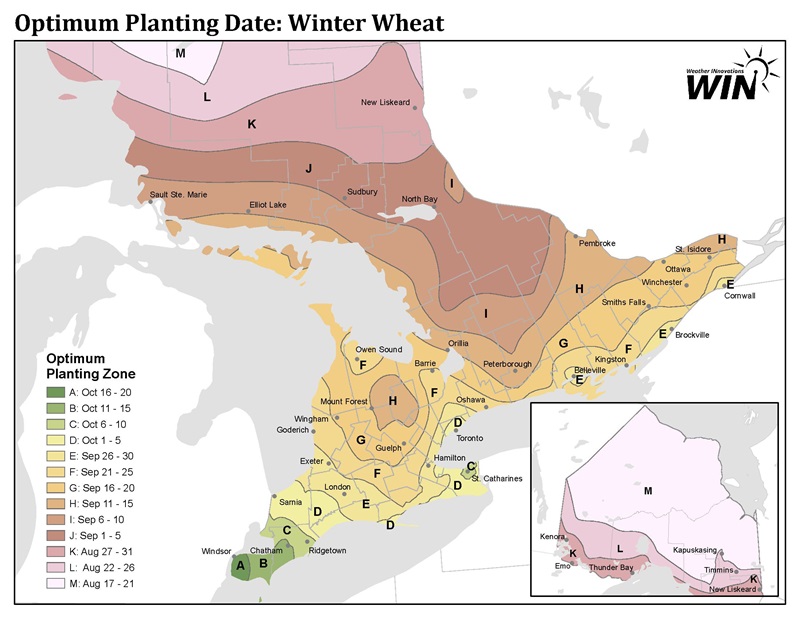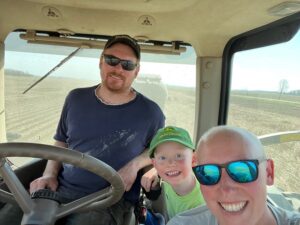Field Observations
SUMMER 2024
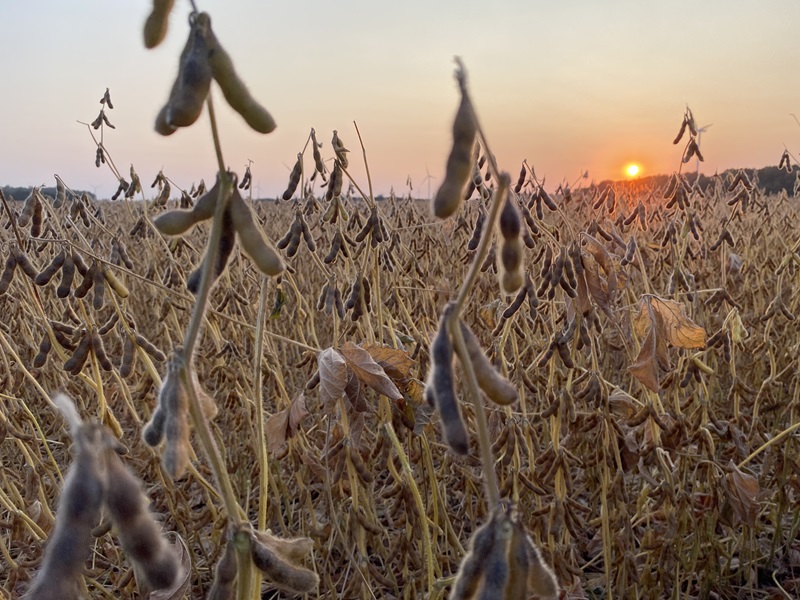
September 19, 2024
Incredible weather for mid-September has helped the corn and soybean crops reach maturity a few days earlier than expected. Soybean harvest has begun, as has winter wheat planting.
Corn
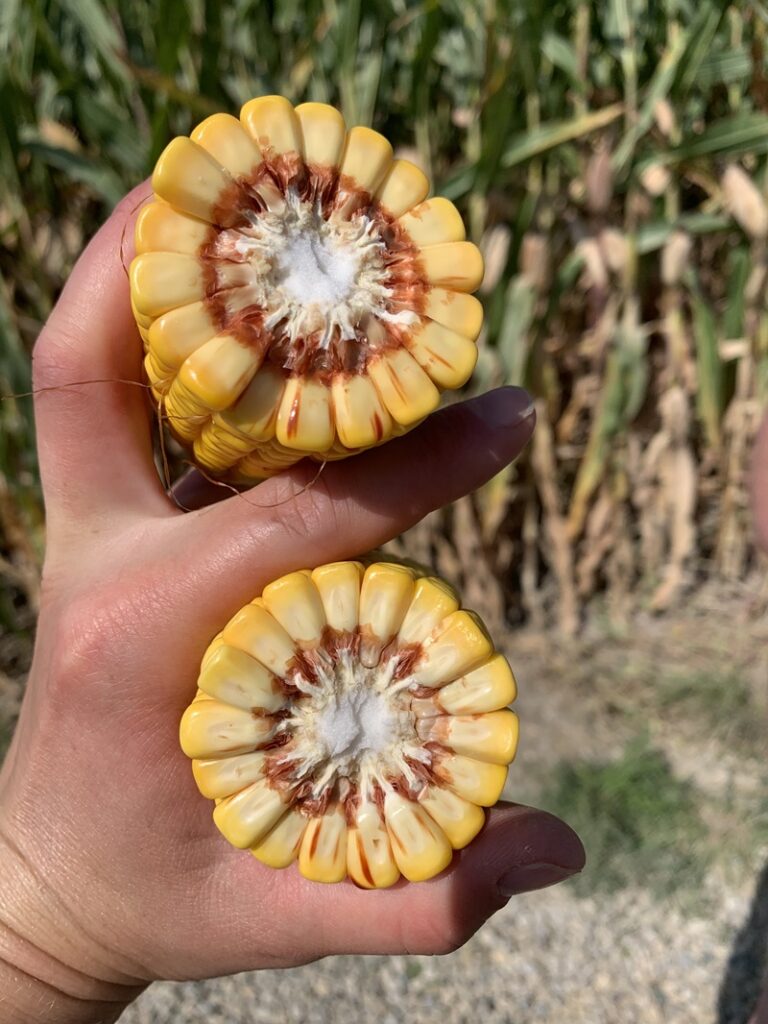
Some corn has reached black layer, which is physiological maturity. Black layer seals the kernel from further development or an increase in kernel weight. The kernel moisture content at black layer formation usually ranges from 30 to 35 per cent. Some corn is still about ½ to ¾ milk line as it moves towards black layer. Continual warm weather will help with the dry down of the crop and reduce drying fees.
Tar spot has flared up the past few weeks in western Ontario, with its continued move eastward in Ontario. Progress and development of the disease were expected with the moisture and temperature conditions experienced in late August. Much of the crop was in or past the dent stage of development, and late spraying would not have had an economic impact at that time.

Earlier fungicide application helped hold back the disease for the expected 14 to 21-day window, but as conditions were favourable, the disease continued its development. The late-planted June corn that would have been in the milk-to-dough stage a few weeks ago may have benefited from a fungicide application as it had a long way to go before maturity. If fields have died down early, be sure to monitor the stalk strength, as the plant may have cannibalized all remaining reserves to finish the grain. Fields with poor stalk integrity should be prioritized for early harvest to avoid lodged corn.
Corn silage harvest is occurring.
Soybeans
Soybean harvest has just begun and will continue as weather and crop maturity allow for the next few weeks across the province. With a couple of weeks of warm temperatures on the outlook with little rain, the key will be harvesting at optimum moisture and not below.
Cereals
With soybean harvest occurring, winter wheat planting is following right behind to help the early establishment of the wheat crop. Conditions look good for a great start to the winter wheat crop.
Much of the crop’s yield is determined at planting. Planting early, at the right population and planting depth, is the start to optimum yields. A consistent seed depth into moisture allows for even emergence. Planting depth is important to ensure root development in the ground for nutrient uptake and to help anchor the plant, preventing heaving during the spring thaw. Usually, a planting depth of one to 1.5 inches is ideal. Seed placement closer to 1.5 inches can help emergence if the soil is dry or the soil is fluffy in order to be placed in moisture for rapid germination.
Seeding rates of 1.2 to two million seeds per acre are the norm based on planting date, soil type, and variety. Lower populations are seen for earlier planting, loamy soils, and tall varieties. Later planting times for individual areas, heavy soil, and shorter varieties benefit from higher seeding rates to keep plant densities higher. As the planting season gets later, seeding rates should be increased to raise the plant density and potential stem number of heads next spring, as tillering may be reduced due to late planting. A general rule of thumb is if planting before the optimum date, reduce rates by 100,000 seeds per acre per week. If planting past the optimum planting date, increase by 100,000 seeds per acre per week.
September 12, 2024
Moderate temperatures this week have the corn and soybean crop progressing closer to maturity. With some help of continued warm temperatures this month, the crop will reach maturity before the frost. Winter barley planting has begun with Winter wheat planting not far behind, it is always exciting to think that planting for the 2025 crop is here! Some thoughts on what to look for in a cereal seed variety selection; yield, Fusarium Head Blight resistance, standability and more as planting approaches are included below.
Corn
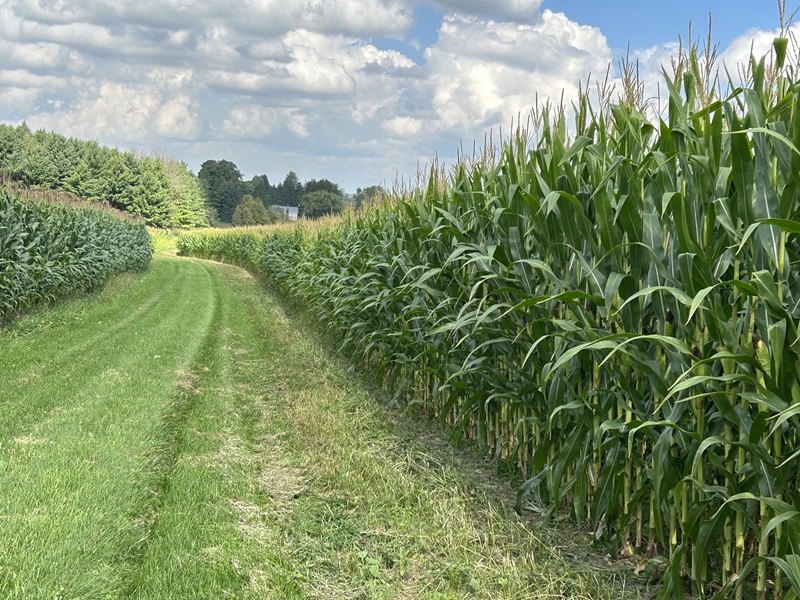
Corn across the province is moving towards maturity (black layer), as the milk line moves towards the kernel tip. Depending on the location within the province and date of planting will determine how advanced the crop is. Variation in maturity could be caused by many different factors like the maturity of the hybrid, planting date, and disease pressure.
At this point, more warm weather is required to reach maturity and help with grain dry down as fall progresses. Good kernel depth and hard, dense starch being packed into the kernel will add kernel weight to maintain maximum yield potential.
If corn plants die prematurely due to frost (some areas of the province received snow this past weekend), drought, or disease, yield loss could be possible, and test weights may be affected. Impact of damage to the plant dying prematurely will vary depending on corn stage. Yield loss and impact to test weight from dough stage – R4 (41% grain yield loss if leaves damaged) to maturity – R6 can be found in this article. Corn plants that die prematurely before true black layer (milk line at 100 per cent) can also have concerns with grain dry down as grain does not have the abscission layer to block migration of moisture in the kernel. If not black layered, rewetting of grain in wet weather could lead to harvest headaches.
Tar spot is still a topic of discussion this year- one of the questions being raised is whether a second application of a fungicide in some situations is warranted. More information on this optic can be found in this article from the Crop Protection Network, sponsored in part by Grain Farmers of Ontario.
Soybeans
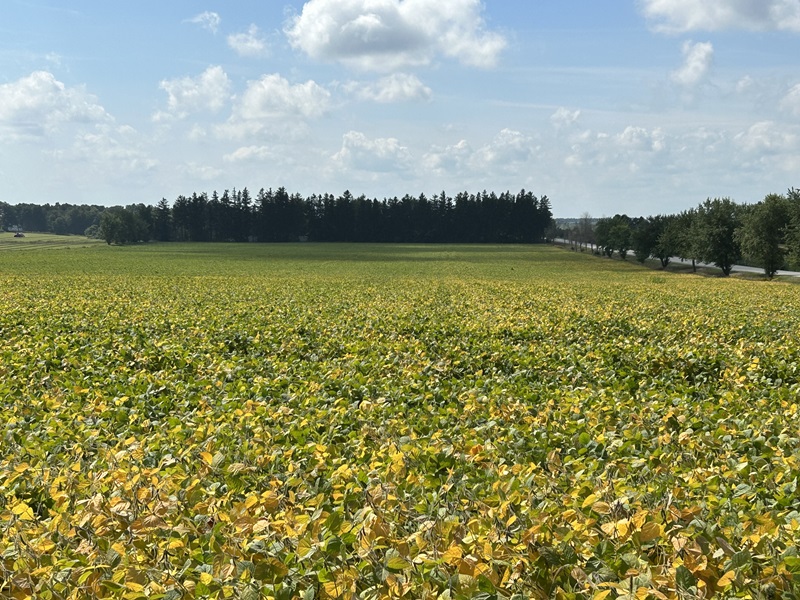
Harvest has just started this past week for some early season varieties of soybeans. Later season varieties and later planted fields will follow in the coming weeks as yellowing and leaf drop is occurring quickly, with the September heat moving the crop to maturity. For those crops that are physiologically mature (R7), it takes roughly 8 to 10 days to reach full maturity (R8) when the crop is brown in colour and 95 percent of the pods are brown. At this stage soybeans will rattle in the pod, and all leaves will be dropped. Another 5 to 10 days once full maturity is reached is typical before seed moisture reaches a harvestable point.
If aiming for a preharvest burndown, spray at the correct timing for the plant stage. Remember all pre-harvest intervals, use the right desiccant, and keep water volumes up. Proper water volumes assist with efficacy. A note that pre-harvest burndowns do not speed up maturity or make dry down faster but instead can improve harvestability, in the case of high weed densities or uneven maturation in pockets of the field. Desiccation should occur when the plants reach R7 (mature colour on pod, plant leaves are yellowing, seed has turned from green to yellow, with the seed separated from the pod as the grain fill process has stopped). At this point desiccation could occur. If desiccation occurs when the plant is not at the correct stage, yield and quality are affected. Speak with your local agronomist to ensure the correct stage prior to desiccation. You must always follow label restrictions for Pre-Harvest Intervals, and check with your grain merchandiser
As harvest begins, remember that now is the time to establish a suitable seedbed for winter wheat planting- spreading chaff evenly, not rutting up fields, and a weed-free field are some of the keys to successful wheat growing.
Cereals
Spring cereal harvest is wrapping up in the province’s northern regions, as weather allows.
Winter barley planting has begun.
As we approach winter wheat planting, be sure to look at the 2024 Ontario Cereal Crops Committee (OCCC) trial data via GoCrops.ca.
In preparation for planting, there are a few things to keep in mind as you evaluate the data. Evaluating yield data for test plot locations close to where you will plant is important. Luckily, the OCCC has several locations across the province to assist with this. Ideally, it is best to plant more than one variety. Selecting early and late maturities can spread the risk of weather and disease-related issues.
Some things to consider when looking at potential varieties.
Yield- It seems to be the number-one trait to consider when selecting varieties, but before picking just high yielding varieties it is advised to thin the list of varieties that are not marketable for the intended marketing plan or ones that are not producible under the upcoming season’s management plans.
Fusarium head blight (FHB) resistance- FHB is a profit-robbing disease. Available varieties have a wide range of susceptibility to FHB. If not using fungicides, select the most FHB-resistant varieties available. A valuable tool is to look at the managed vs. unmanaged trials. Be sure to know how to manage wheat for the best possible yields.
Standability – As harvest nears, the talk turns to standability. Lodging can reduce yield, quality, and cause headaches at harvest when picking wheat off the ground. If applying high N rates/manure, consider a shorter variety or the use of a plant growth regulator.
Seed size – Make sure to know your seed size and adjust the drill or planter to plant to the correct target population.
Seed Quality – Do a germination test to make sure you know what quality of the seed you are planting and make adjustments if the germination rate is low to ensure you hit your target plant population
Disease resistance – Resistance to other diseases is important to consider because infections lower yield potential. While most diseases can be managed with seed treatments and fungicides, the initial treatment and management cost may be higher.
Spread out risk with early and later flowering varieties – This allows the risk for disease to lower along with spreading out harvest so that efficient harvest can be completed.
Management – Do current crop management plans coincide well with potential varieties?
Remember, cleaning and treating seed before planting is highly recommended if using bin-run seed. Treating seed helps prevent dwarf bunt and other diseases. Planting certified seed for next year’s bin run is a good management strategy. And remember to clean out handling equipment that might handle treated seed.
And finally, wheat that is planted in a timely manner gives the crop a solid chance for high yields. Get wheat in the ground as soon as possible.
September 5, 2024
As the calendar turns to another month in the year, soybeans are also beginning to turn and advance toward maturity. Now is a great time to assess the areas of variability in the fields as maturity differences appear. This can help point to any underlying issues before crops reach full maturity.
Corn
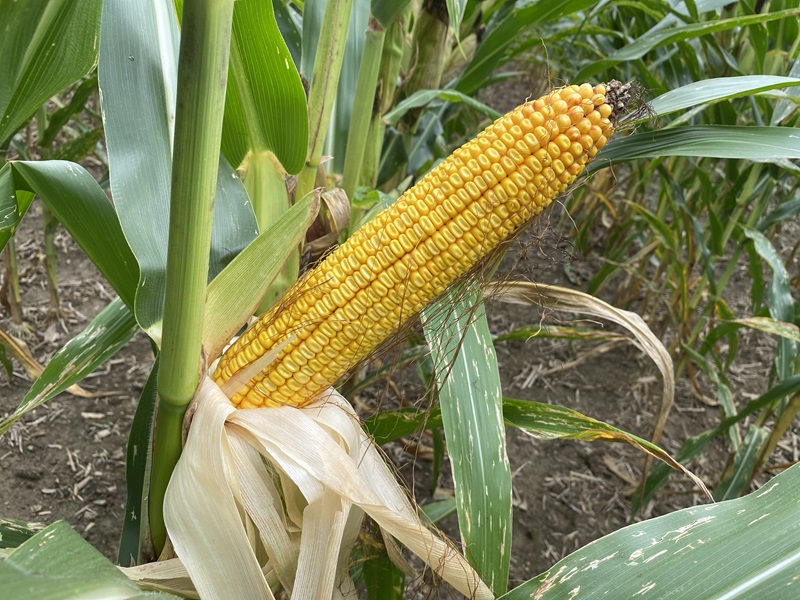
The corn crop is filling grain this week as it is in the dent (R5) stage, with a visible milk line starting to move across the face of the kernel. Some fields are starting to show brown husks, a sign that the milk line is getting around the halfway mark before reaching the black layer. Timely rains will help fill the kernels over the next few weeks. Depending on plant health, if the plants are still very healthy, full kernels with good tip fill and good test weight can be expected this fall.
Now is a great time to look for insects and their damage – did certain treatments work better than others? Also, look at how hybrids are finishing the year off – are there some with less disease, do some have better stalk strength, or did the timing of rainfall and pollination impact grain development? Plants at this point of the year can also be seen with the bottom leaves drying up, indicating a potential nitrogen shortage for the plant. By R1, the plant has taken up about 65 per cent of its nitrogen requirement, with the rest being taken up during the grain fill period. As nitrogen is a mobile nutrient within the plant, it will move from the bottom leaves to the cob for grain fill, cannibalizing the lower leaves while the nutrient moves to the area of higher demand.
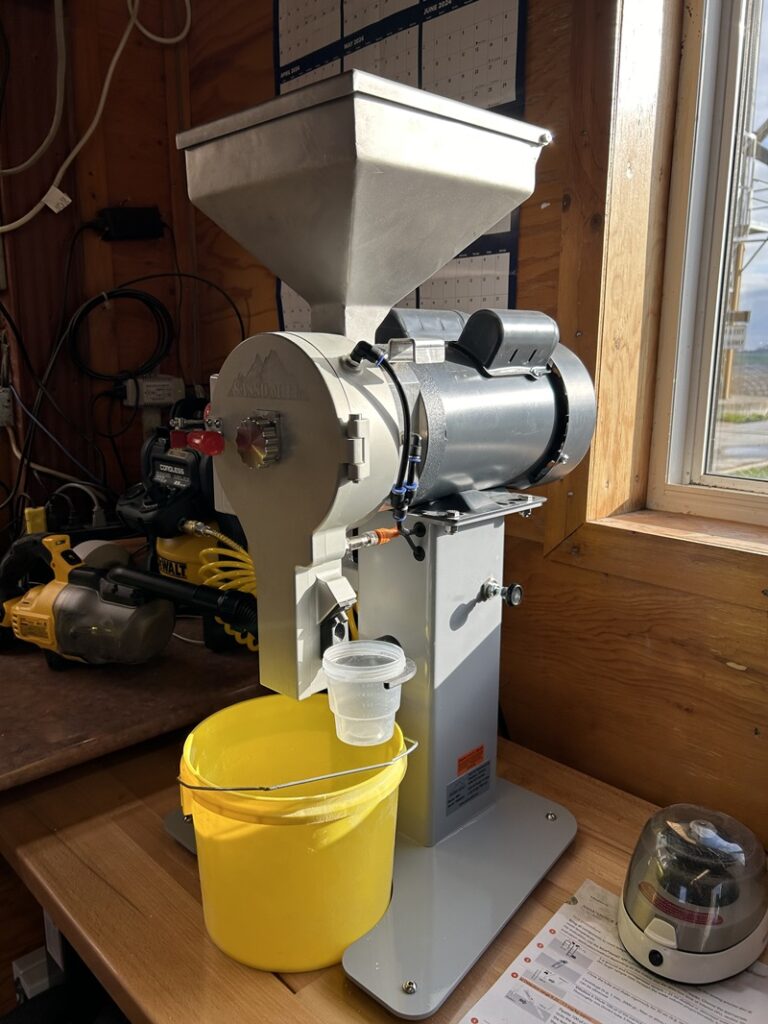
As harvest approaches, it is valuable to be aware of the proper DON Testing procedures and how to achieve a consistent, accurate result. Deoxynivalenol (DON) is a mycotoxin naturally produced by the fungus that causes Gibberella ear rot in corn. Infection occurs through the corn silk channel when ideal temperatures (approximately 27°C) and higher humidity are present. Cool, wet conditions after pollination favour continual disease development and determine the level of infection. Effective sampling, detection, and quantification of DON are challenging due to its uneven distribution on the ear as well as its presence across the field, resulting in infected and non-infected kernels in the same grain sample.
Accurate sampling is crucial to reduce false readings and improve grain management during delivery. University of Guelph research has highlighted essential improvements to the DON sampling protocol for better testing accuracy. More can be learned about proper sampling and testing techniques in this video.
Ideal conditions for tar spot development have led to the disease being reported in more counties, as far east as Toronto. Most fields are past the economic spray point.
Soybeans
Soybeans are starting to have yellow leaves or even begin to drop leaves across the province. Earlier planting dates and earlier varieties are maturing and are at the physiological maturity (R7) stage. Currently, uneven field maturity indicates to farmers that not everything is uniform in the field. Fields that were replanted and patched up this spring will show different maturity due to planting date differences. Fields that were planted during one planting period may have low spots that could be greener due to less stress due to more moisture, or it could be delayed spring emergence due to waterlogged conditions. Areas of fields that are turning yellow quicker than others need to be investigated, as it may indicate disease or insect pressure. It might be soybean cyst nematode (SCN) populations in the soil or late-season root rots. Sudden death syndrome (SDS) can show up at this time of the year as it has 2 phases: a root rot phase and a foliar symptoms phase, which usually shows symptomology after flowering. Yellowing could also be moisture deficits, but it is usually a mystery until scouting. Scouting the crop never stops, and finding the cause of the problem as soon as it is seen is important. Diagnosing leaf, stem, or root issues will be difficult at harvest, and proper identification of problems will lead to better management of the field in future years.
Soybeans in the fuller maturity area of the province, mostly above 3,000 crop heat units (CHU), still have many green fields due to late planting, and the soybeans are still at the full seed (R6) stage, but some early fields are starting to turn yellow. Rains last week have helped to finish off the crop.
And with the maturation of soybeans comes a return to school. A friendly reminder that school buses are now on the roads. Be on the lookout and stop for all buses. And just because school buses are running doesn’t mean that kids will all be at school due to sicknesses, etc., so be on the lookout for kids when visiting farms and travelling around the countryside.
Cereals
Spring cereal harvest is still ongoing.
Winter wheat planting will begin in the coming weeks. If using equipment for harvest that is also handling treated seed ensure proper cleanout procedures are followed.
As winter wheat planting approaches, have a plan in place for fall weed control. Fall weed control (or similarly post-harvest weed control on harvested cereal fields) allows for targeting weeds that emerge later in the growing season and setting up a cleaner field for the next crop being planted. More can be learned here.
August 29, 2024
Field conditions and weather are still favourable for disease development as corn and soybean crops move closer to maturity. Crops are progressing well, considering many later planting dates. However, continued heat will be essential to reach maturity as fall approaches. Spring cereal harvest continues as the weather allows.
Corn
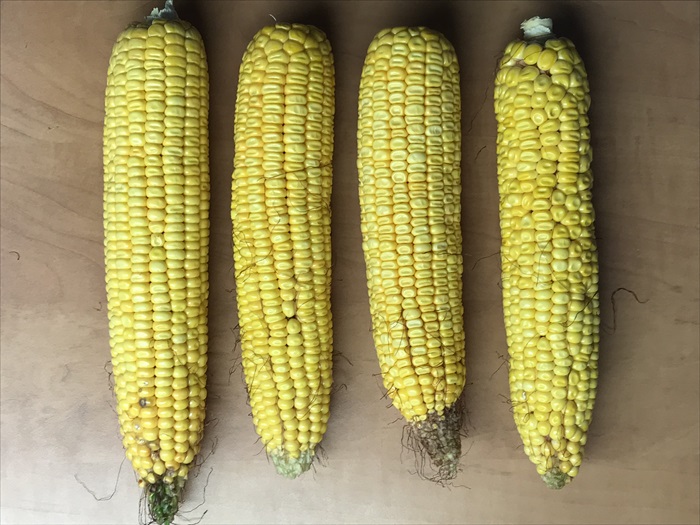
The earliest planted corn is starting to form a visible milk line as it hits the dent stage (R5), while the majority of the crop is in the dough to early dent stage this week. June planted corn is at blister to milk stage. It is imperative to know growth stages and if grain will mature before killing frosts. In some cases, alternative uses other than harvesting for grain may be advisable for late-planted fields. Through September (if warm weather continues), corn will see rapid movement of the milk line as the plant closes in on physiological maturity (black layer). The next few weeks are the critical grain fill period for the corn crop when the plant focuses all its energy on filling the kernel. The depth and weight of the kernel will be determined over the next three weeks. Maximum sunlight (solar radiation) and adequate rainfall (moisture) will provide the crop with the best opportunity to fill the kernels with starch.
The milk line of the corn kernel is the line on the kernel where the hard starch meets the milky wet part of the immature kernel. This milk line will continue to progress to the tip of the kernel as the corn produces more starch and packs it into the kernel. Once the milk line has reached the tip (sugars converted to starch), the kernel is full, and the black layer (abscission layer) is formed, which restricts the transfer of sugars in or out of the kernel.
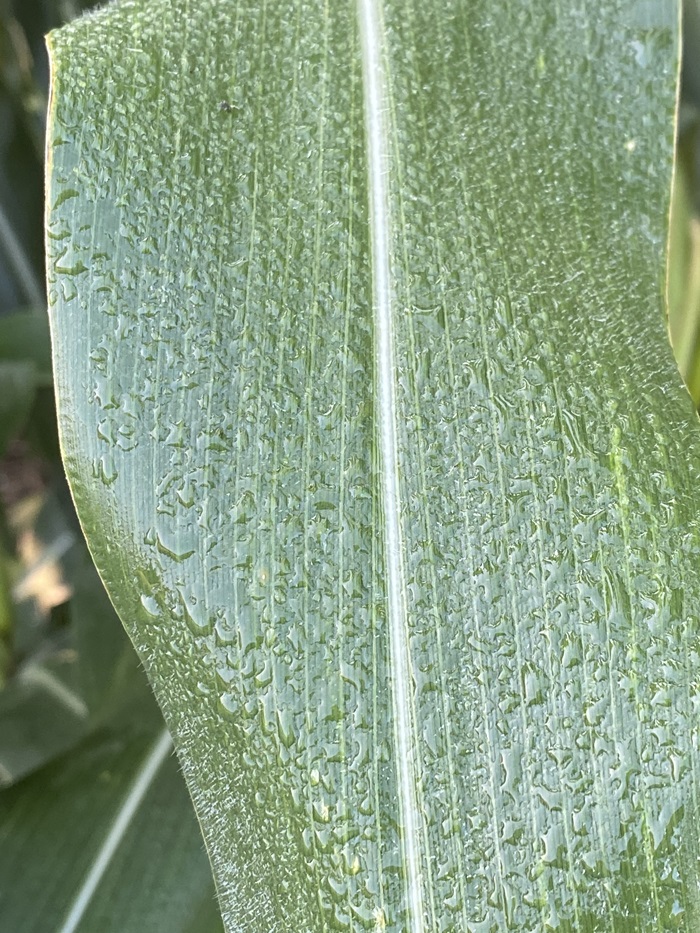
From May 1 to August 26, there were 2436 crop heat units (CHUs) in Elora, compared to the 54-year average of 2320. Each day of the 2024 season appears to have accumulated slightly more CHU than the average, and as many have shared, it has been a warm year overall. Ridgetown, Kemptville, and Earlton are all also showing higher-than-average CHU accumulation this year.
Be on the lookout for tar spot. As humid, foggy conditions allow for extended leaf wetness over multiple hours (ideal is 7 to 8 hours) and warm weather (15 °C to 21 °C), ideal conditions for tar spot development have occurred. How drastically tar spot impacts yield is due to when the disease arrives on the plant compared to the plant growth stage (more mature crop will see less of an impact). As there is still a lot of corn in the early reproductive stages with Tar spot appearing, discuss with your agronomist whether a fungicide application may be warranted to protect the plant for another few weeks.
Soybeans
Soybean pods continue to fill this week, with many fields reaching the R6 (full seed) stage of development. Any stress at this point of the season will prompt the smaller pods to be dropped from the plant, as the plant’s main goal is to fill the current pods so that excess pods will be lost during periods of stress rather than continue seed formation. Looking at the seven-day forecast, warm weather and some rain on the weekend should allow for good seed formation to continue.
Soon, especially in shorter-day soybeans, R7 (beginning maturity – when one pod on the stem has reached mature pod colour) will be reached. The change from R6 to R7 can span roughly nine to 30 days, depending on the weather and other factors affecting the plant.
A full moon having passed a week ago allows some in higher elevations and more northern locations to breathe a small sigh of relief, as heavy frosts should still be a few weeks away. September 17 is the next full moon to be seen.
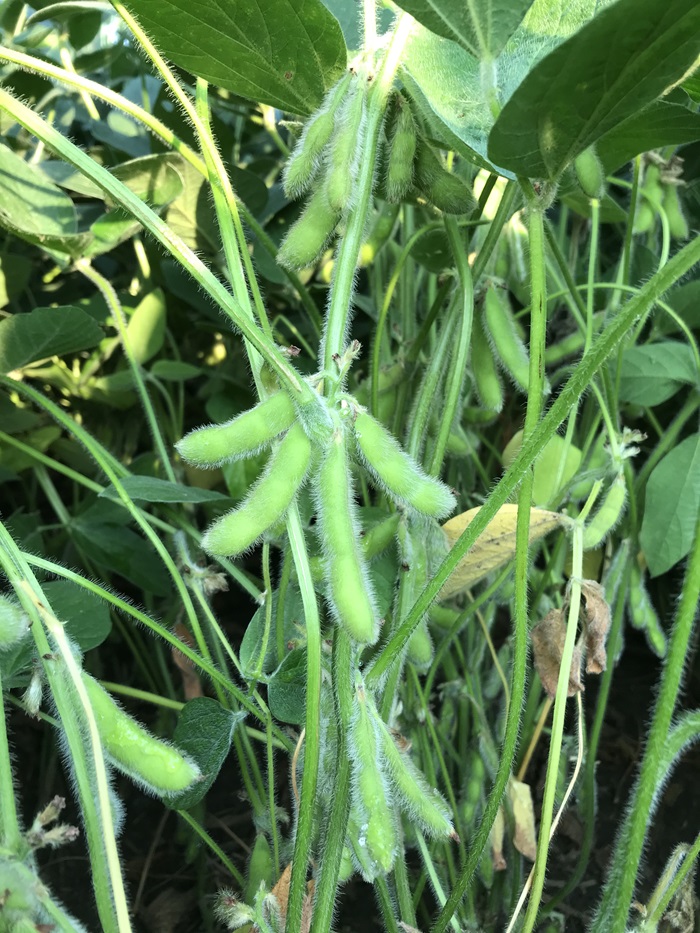
As harvest approaches, be sure that grain handling equipment is clean and ready to handle harvested grain, especially if it has handled treated seed or fertilizer. More info on handling treated seed and clean out can be found here.
Yield estimates are being done this time of the year. A simple method to calculate the estimated yield for soybeans is (plants/acre x pods/plant x seeds/pod) ÷ seeds/lb)) ÷ lb/bu = average bu/acre
An example of this could be: (134,000 plants/acre x 24 pods/plant x 2.8 seeds/pod) ÷ 2,500 seeds/lb) ÷ 60 lb/bu = 60 bu/acre average.
Using 2500 seeds/lb is assuming the plants are healthy. Stressed plants could be assumed to have smaller seeds and more seeds per pound, so the number should be increased.
Yield estimates should be taken throughout the field and then averaged in order to be more accurate.
Cereals
Spring cereals are being harvested as the weather allows.
Winter wheat trials are posted and available at GoCrops.ca. Be sure to change any bookmark that might have been for the legacy cereals site to GoCrops.ca.
August 22, 2024
Some rainy days with over 4” of moisture falling in some areas, certainly caused any soils that were edging towards the dry side of things to become saturated again. Rains also brought cooler weather which slowed down crop development. Crops overall, are progressing but are variable across the province in crop growth stages, some heat would be nice in the next few weeks. Be on the lookout for disease both in corn and soybeans.
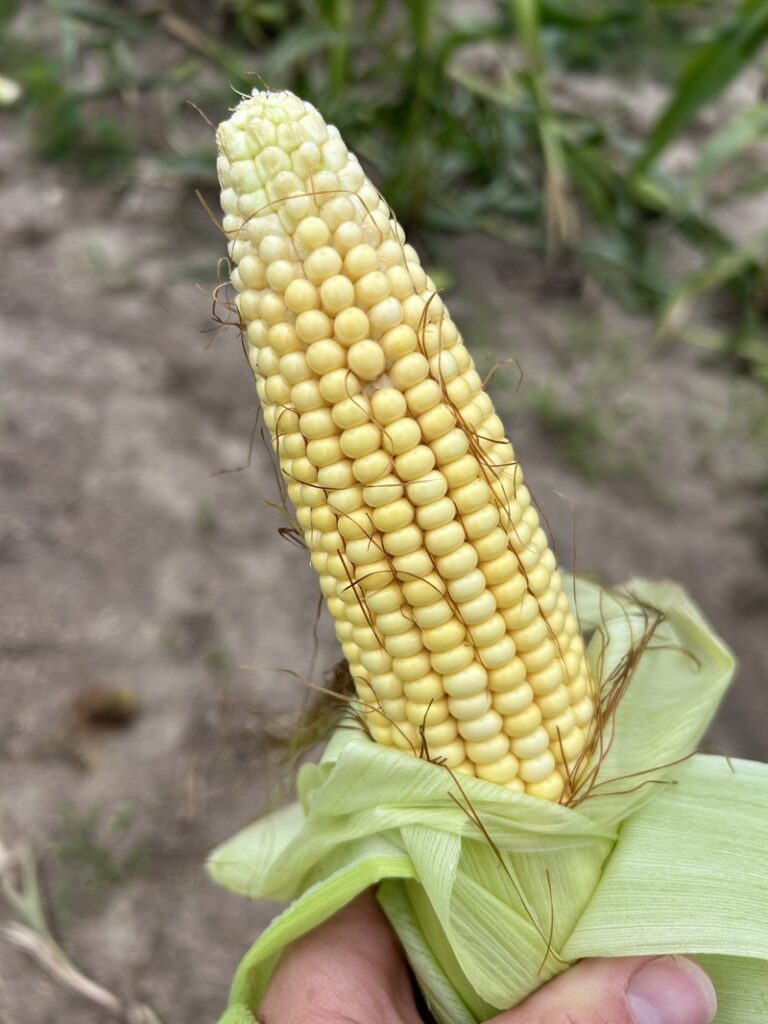
Corn
Having recently travelled from Sarnia out to Ottawa along the 402/401 corridor, it was still apparent that there is lots of variability in crop staging and how plant stands were handling the onslaughts of heavy rain regularly throughout the growing season.
The majority of the corn is at the R3 (milk) stage, with earlier planted fields at R5 (dent) stage. Once kernels dent, the average grain moisture at this time is 55 per cent. However, as shared above this has been a year of variability and corn fields planted in June are just at R1 to R2 (pollination to blister) stage.
Lots of moisture and humidity at this time of year with moderate temperatures are ideal for leaf diseases, which are beginning to show up in fields. Northern corn leaf blight, Eye spot and others are beginning to be identified. More on these diseases and others can be found on the past Grain Farmers of Ontario GrainTalk Webinar.
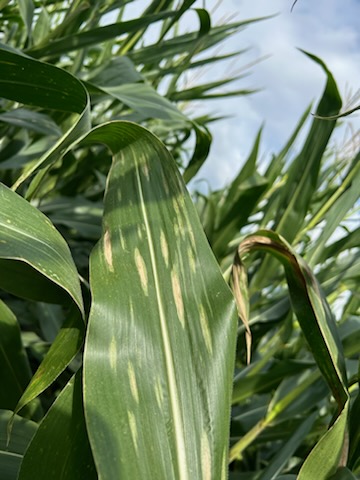
Eastern Ontario (Northern Corn Leaf Blight)
For corn growers growing corn on corn, it is necessary to scout fields, especially for corn rootworm beetle populations and rootworm damage. Ideal weather has increased rootworm populations over the past years, and damage to corn roots has been showing up. It is imperative to manage this pest, as yield and plant standability can be drastically reduced. If rotated corn fields are beside corn-on-corn fields, the rotated fields can still be at risk for damage. More details on scouting and how to manage this pest can be found in our Grain Farmers of Ontario Agronomy Alert and the GrainTALK Farmer Forum: Corn Rootworm Resistance.
It is that time of year again when yield estimates are being taken, on fields that are developed enough. A quick method for determining potential yield is kernels per cob multiplied by cobs per acre and dividing the kernels by bushel.
Detailed Yield Calculation
Step 1. Ears per Acre – At each sample site, measure 1/1000th of an acre along the row (30″ row = 17.4 feet in row length). Count the harvestable ears in the 1/1000th of an acre. Select random cobs and count kernels where there are complete rings of kernels around the cob and avoid counting kernels on the extreme ends of the ear (butt and tip).
Step 2. Kernel rows per ear – Count the number of kernel rows per ear on every fifth ear and determine the average.
Step 3. Kernels per row – On the same fifth ear, count the number of kernels per row and determine the average.
Step 4. Calculate – Kernels per ear by multiplying row number (step 2) by kernel length (step 3). Take the average number of kernels per ear and calculate by the average number of average cobs per 1/1000th acre, then divide by the factor representing the number of kernels per bushel, usually 90.
Yield (bu/acre) = (average # kernels per cob) x (# cobs per 1/1000 acre) / factor
14-row cob with 30 kernels in a row = 420 kernels per cob
(420 kernel cob) x (32 cobs in 1/1000 an acre) / (90 factor) = 149.3 bushels/acre estimate
Step 5. Repeat this procedure at a representative number of sample sites in the field. Calculate the average yield potential of all the sites to get an estimate of the yield potential of the entire field.
*It is important to use the right factor when estimating yield to get a realistic estimate. Kernel weight and kernel size will have a large impact on the calculation.
| Growing conditions | Factor | Range in kernel number/bushel |
| Excellent – large and heavier kernel | 75-80 | 75,000-80,000 |
| Average – average kernel size and weight | 85-90 | 85,000-90,000 |
| Poor – smaller kernel, lighter kernels | 95-105 | 95,000-105,000 |
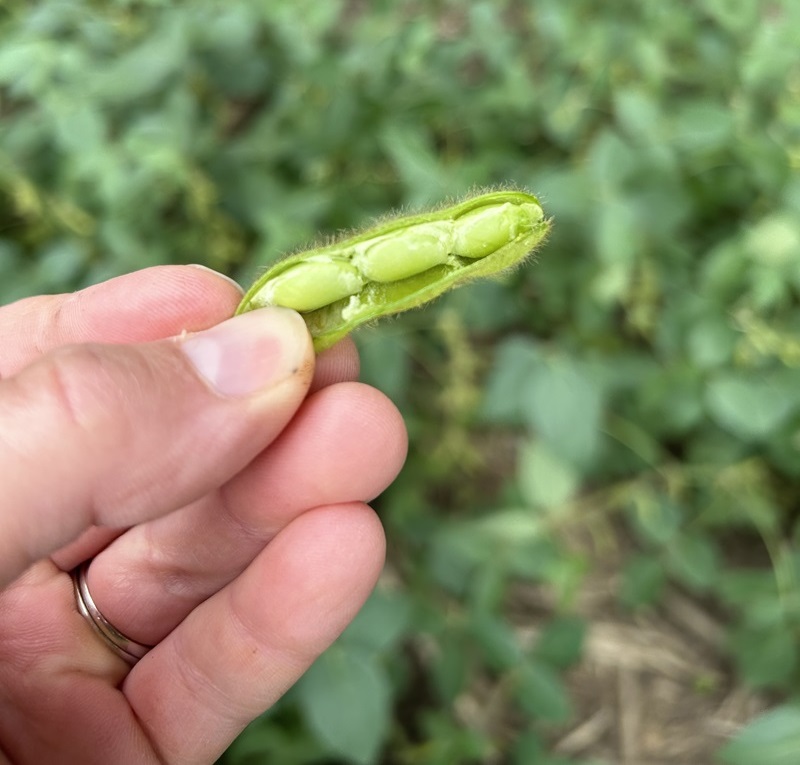
(R 6.5 the seed will separate from the
membrane within the pod)
Soybeans
Soybeans are in the R5 to early R6 stage, as the pods near the top of the plant are green and filling the pod. Soybeans stay in the R5 stage for roughly 11 to 20 days. As bean sizes increase on the top pods, the growth stage progresses towards R6. During R5, plant nitrogen fixation peaks, while plants also attain maximum height, node number and leaf area at this stage. Flowers are hard to find as the plant reaches this maturity point and is focused on filling the pods. Sunlight and good moisture conditions over the next few weeks will help size up the soybeans.
Travelling the province there are some weedy fields, harvest may be a bit of a challenge with the weed growth. Desiccation closer to soybean maturity at 80% leaf drop may be a choice in some of the troubled fields. If growing IP beans, volunteer corn in the sample is a big NO along with staining from nightshade. Be sure to plan for corrective actions or plan for loss in premiums. If there are resistant weeds, take note, and make plans to control resistant weeds in next year’s crop as it will become a bigger problem.
Be on the watch for White Mould, some helpful identification tips can be found in the link.
Cereals
Spring cereal harvest has begun in Ontario as weather and plant maturity allows. Cover crops are being planted after harvest, as moisture allows.
A reminder that winter wheat trial data is being posted online from the Ontario Cereal Crop Committee as it becomes available at GoCrops.ca.
The Agricorp deadline to report winter wheat yields for Production Insurance is September 1.
August 15, 2024
The corn and soybean crops are developing well across the province, with grain development occurring as the corn is staging at R2 to R4, depending on planting date. Soybeans are full of pods and are staging from R4 to R5. Be on the lookout for disease – timely identification can allow for awareness of the problem and the ability to take future steps to limit the incidence.
Corn
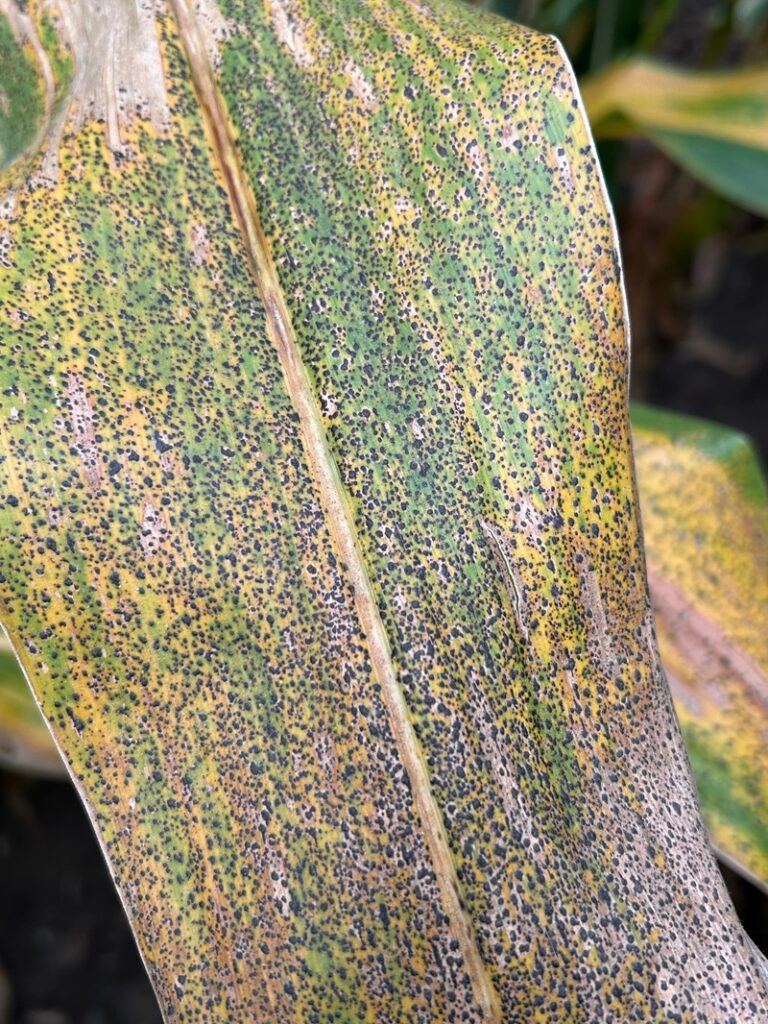
Corn development across the province varies widely as the planting window this year ranged from the end of April to late June. For the most part, the crop stage for the June planted crop is in the R1 to R2 (pollination to blister) stage, and early planted corn is in the early dough (R4) stage. With the majority of the provincial crop in the R3 (milk) stage. On average, provincially, the ground moisture has been exceptional to excessive as crops continue to have ideal development with no drought stress. That said, there are small localized pockets that have missed the rains and do have drought-stressed crops but are limited to a small geography.
Tar spot is still a disease to keep scouting for, more can be learned on this disease from previous weeks’ Field Observations. If disease is just found, consider your corn growth stage and the number of days to harvest before applying. Be mindful of the preharvest interval required for the product you are applying to control the target disease. As can be seen in the below picture (taken last year), tar spot lesions can aggressively impact the green tissue and ability of the plant to photosynthesize, affecting crop yield through premature death.
Soybeans
Soybeans are in the R4 (full pod) to R5 (beginning seed), and as shared in past posts, with some later planted fields delayed in maturity.
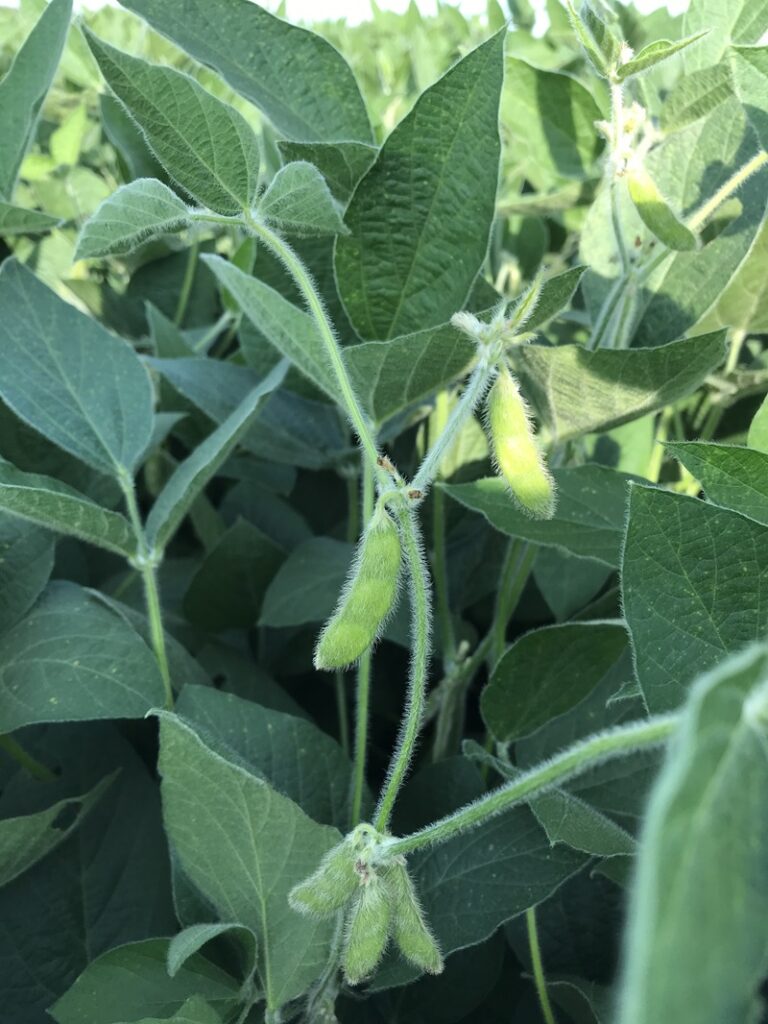
Excellent canopy growth continues, and more pods have formed on the upper part of the canopy. Flowers are petering out as the remaining pods will continue to set seed over the next weeks. It is hard to get a yield estimate yet as pods are still forming, and any stress in the next couple of weeks could abort the seed or reduce seed size.
Fields are starting to lodge, as earlier plant development had ideal growing conditions with timely rains and adequate heat, creating longer internodes resulting in lanky plants. Higher plant populations and heavy rainfalls and wind have contributed to the lodging.
Some dead plants are showing up in the fields, make sure to look closely and identify the cause. In some cases, numerous fields have experienced wet roots for much of the growing season- potentially causing root rots. Also, white mould symptoms might be developing as well. Look for various insights in the field to help identify the cause. Knowing the correct cause of a problem will lead to better decisions in the future, such as rotation, population and variety selection.
Cooler nights are signaling we are in the last half of the summer as the day length is shortening. Even though it is still August, the soybean harvest will be here before we know it. Now is a great time to ensure that grain handling equipment is free from any treated seed or foreign material. Some helpful tips to reduce the chance of contamination can be found in the Grain Farmers of Ontario Handling Treated Seed Factsheet.
Cereals
Winter wheat harvest is mostly wrapped up. Spring cereal harvest will begin in the next couple of weeks.
Preliminary winter wheat trial data is starting to be posted online by the Ontario Cereal Crop Committee (OCCC). Be sure to visit GoCrops.ca for data.
August 8, 2024
Overall, winter wheat harvest is close to finishing, if not complete for many areas. Corn has pollinated and is packing starch in the kernels and soybeans are beginning to produce seeds, with an understanding that there is variability in stages across the province. Overall, many areas have variable crops due to the excessive amounts of moisture in some areas. At this point of the season, timely rains will be ideal to keep crop progress moving.
Corn
Corn is staging from VT to R4 (dough stage). R4 stage occurs roughly 24-26 days after silking and will have the kernel turning from milky to doughy consistency.
Tar spot should still be scouted for. Depending on when the disease appears within the canopy can determine how much of a yield impact it will have. Note that Tar spot has an incubation period of 2 to 3 weeks before the infection is visible on the crop’s leaves. Spraying needs to take place in most cases between tassel emergence and blister stages for a one-pass approach. Fungicides do not cure the disease that is established but give protection from the infection for several weeks (which fungicide used determines the length of protection). There are some who aim for a 2-pass approach, on fields that have a previous history of disease as it can be infected earlier if a dense crop canopy and ideal weather conditions prevail. The main purpose of a 2-spray approach is to maintain green plant tissue during grain fill to maintain maximum yield potential. The one pass targeted at fresh silk timing (V1) seems to be the key economical timing for average conditions.
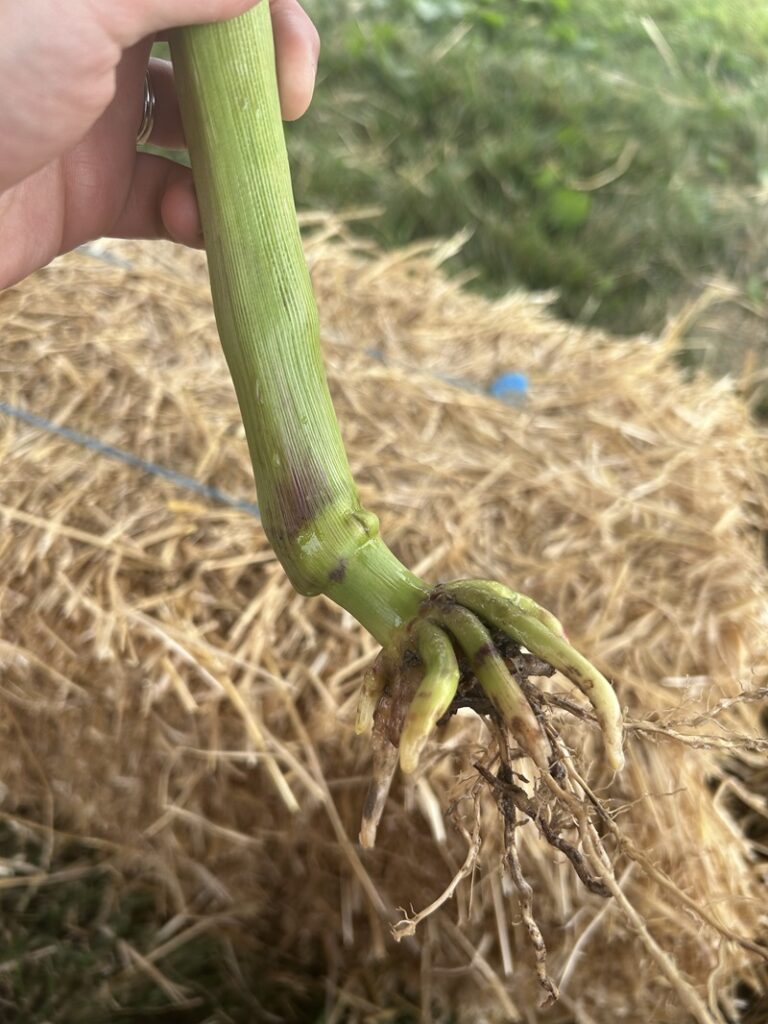
Over the past few years, western bean cutworm (WBC) has shown peak flight in the last week of July and the first week of August. vigilant with monitoring for the pest. For scouting and threshold criteria read more here.
Corn Rootworm (CRW) is also a concern. Roots damaged by CRW can be weakened enough that plants lodge or that the stalks have a gooseneck shape (which can make pollination and harvest challenging). To learn more about this pest and CRW resistance, watch this GrainTalk webinar featuring Tracey Baute, OMAFA entomologist and Erin Hodgson, extension entomologist specialist with Iowa State University.
Soybeans
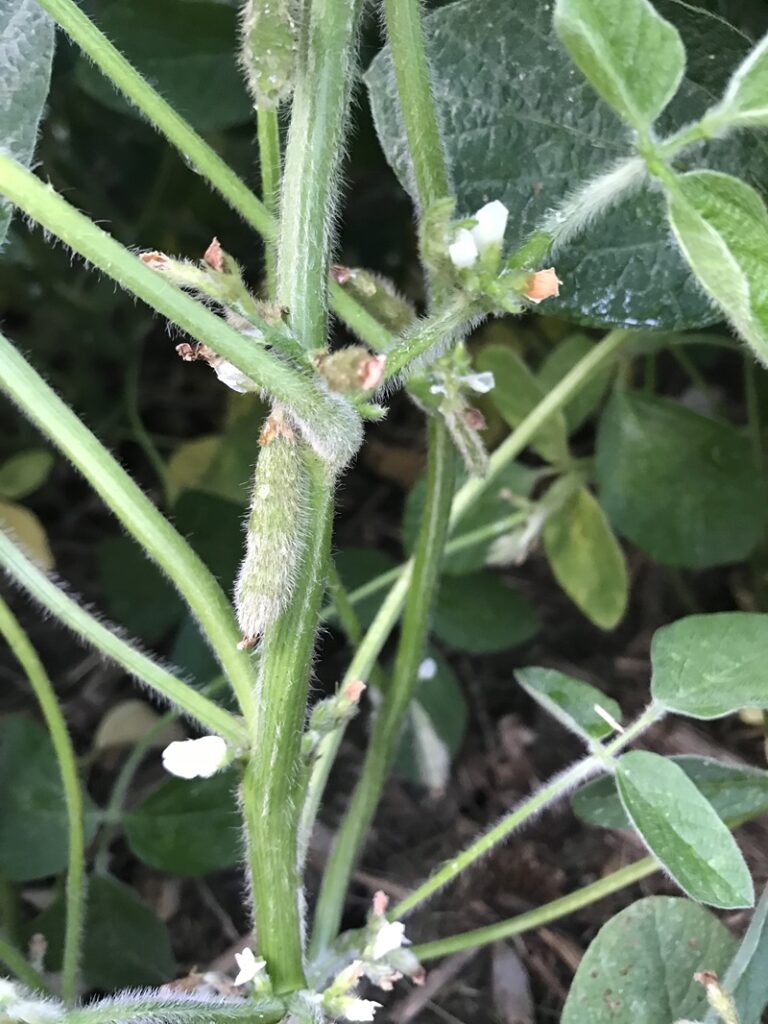
Soybeans are staging from vegetative stages (late planted) to R5 (beginning seed- seeds are 1/8” long in the pod on the 4 uppermost nodes on the main stem).
Still be on the lookout for insects; bean leaf beetles, aphids, and spider mites, with the heavy rains, they may have been washed out, but it good practice to continue to scout for them.
Cereals
With wheat harvest wrapping up for most of the province, with 90 to 100 per cent complete, it is time to consider cover crops. The Cover Crop Decision Tool is a greate resource for finding out what cover crops will work best on each farm. This valuable tool is supported by Grain Farmers of Ontario – much of the research that the organization funds is included in the tool.
For information on winter wheat quality across the province view the Ontario Wheat Quality page on the Grain Farmers of Ontario website.
Spring cereal harvest should be beginning in the next couple of weeks.
Soil compaction
Some winter wheat was harvested in less-than-ideal soil conditions and some compaction was caused.. Read the Grain Farmers of Ontario Factsheet on Soil Compaction for some short term and long term considerations to help mitigate compaction.
August 1, 2024
Where has the summer gone? After a few incredible harvest days, the winter wheat harvest is close to wrapping up, while fungicides are being sprayed on both corn and soybean acres where warranted.
Corn
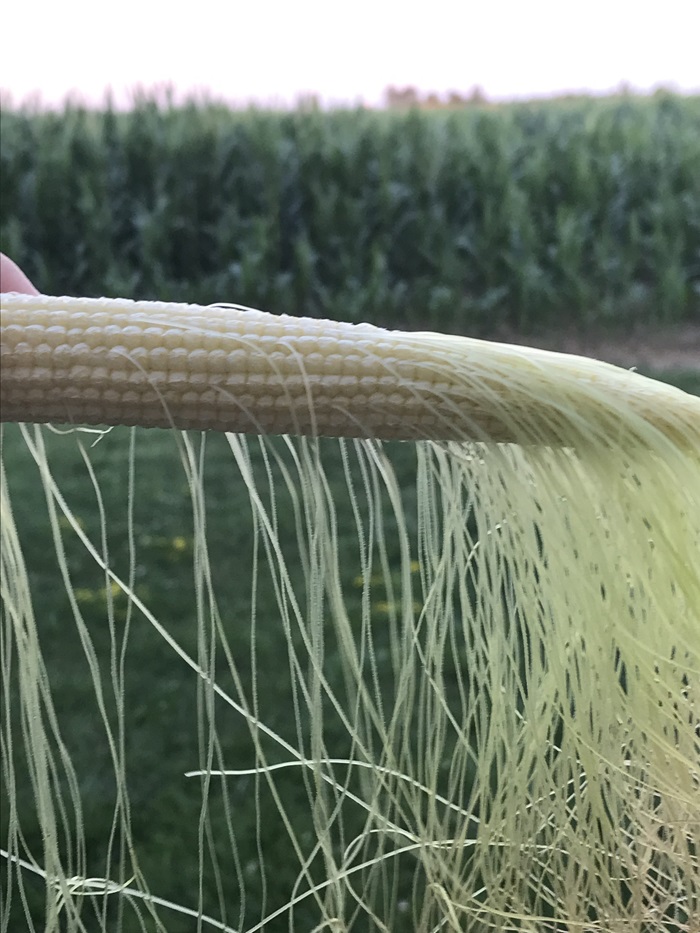
Corn is currently staging from the VT to R2. Some early planted corn has reached the early R3 stage (milk stage, kernels turning from white blister to yellow), which occurs roughly 18 to 20 days after silking.
After pollination, it is a great time to do a pollination check by performing a shake test. To do a shake test, husk back the ear after pollination and shake with the tip of the cob towards the ground for silks to fall off the cob. Silks remaining attached will be the fresh green live silks that have not been pollinated. Kernels will not form if there is no more pollen or the live silks are not outside the husk.
Keep an eye out for tar spot in fields; in 2021, the disease reached as far north as Simcoe County. Look in the upper canopy for infection that has been blown in on storm systems. Look for black, slightly raised spots on the leaves that do not wipe off. Learn more about tar spot.
With later planted corn pollinating later in the season, there may be a higher risk for Gibberella ear rot infection and potential DON accumulation due to the environment during pollination. Speak with your agronomist and create a plan for fungicide applications if warranted.
Soybeans
Many soybeans are close to a critical stage and need moisture to help determine a productive yield. During this period, there are large demands for moisture. For much of the province this year, moisture is not a problem; however, soil available moisture can change if drought periods arise over the next few weeks. Soybeans are currently in the vegetative (late planted) stage, staging up to R4 (full pod). R4 to R6 growth stages are when the plant starts really accumulating dry matter in pods and seeds. Stress during this time can cause major yield reductions, more than any other period of the soybean’s growth.
Aphid populations have exploded in some regions of the province, warranting spray due to the number of pests – 250 aphids per plant- and are increasing, with a lack of beneficial insects. More can be seen on thresholds and scouting in past field observation reports.
Spider mites are creeping into fields. Be on the lookout for areas close to field edges and where grass has been cut; see more on this in last week’s field observations.
Soybeans are starting to show the symptoms of root rots (Rhizoctonia, Fusarium and Phytophthora) due to wet, saturated ground.
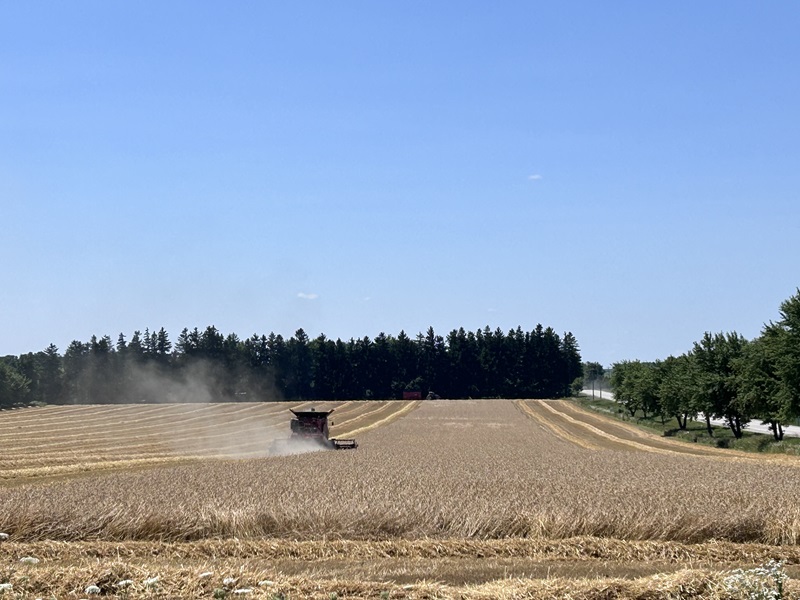
Cereals
Winter wheat harvest is 80 to 100 per cent wrapped up across the province. Many are reporting average to above average yields, with good quality. With good yields, there has also been a high straw yield. Many remove the straw from the field to use for animal bedding. However, straw has great benefits when left on the field, including increased organic matter, increased residue to reduce soil erosion, and a valuable source of nutrients that can be broken down back in the field.
The table below provides an overview of phosphorus and potassium levels removed from one ton of straw and the corresponding estimates of fertilizer costs to replace those nutrients.
| Nutrient | Avg. to Max. Removal (lbs actual/ton) | Fertilizer | Fertilizer Replacement (lbs/ac) | Fertilizer Cost ($/lbs) | Value ($/ac) |
| Phosphorus | 3.2 – 6.0 | MAP (11-52-0) | 6.5 – 11.5 | 0.60 | $3.90 – 6.90 |
| Potassium | 16.8 – 42.5 | Potash (0-0-60) | 28 – 70.8 | 0.50 | $14.00 – 35.40 |
| Total value ($/acre): | $17.90 – 42.30 | ||||
| Total value (¢/lb of straw): | ¢ 0.8 – 1.92 |
*A MAP value of $1320/metric tonne and a potash value of $1080/metric tonne were used in these calculations.
Source https://fieldcropnews.com/2022/07/ontario-field-crop-report-july-27-2022/
Spring cereals are in the final stages of grain fill and will be harvested in the next 2 to 4 weeks.
Soil sampling and cover crops
After winter wheat harvest is an ideal time to complete some soil sampling to get a better understanding of soil nutrient levels for upcoming nutrient applications. According to the 4Rs (right rate, in the right place at the right time and from the right source), soil sampling should occur every four years. Making fertilizer recommendations without a soil sample or utilizing a sample that is older than four years does not meet the 4R requirements.
Cover crops after winter wheat is a great choice to increase soil health, keep nutrients from leaching and increase soil organic matter. The Cover Crop Tool uses Ontario-based research to help find the best cover crop to meet each operation’s goals.
July 25, 2024
There were another beautiful few days weather-wise in Ontario at the start of the week, allowing winter wheat harvest to progress across the province. Corn and soybeans are both in the vegetative to reproductive stages, depending on planting date. Be prepared to manage disease.
Corn
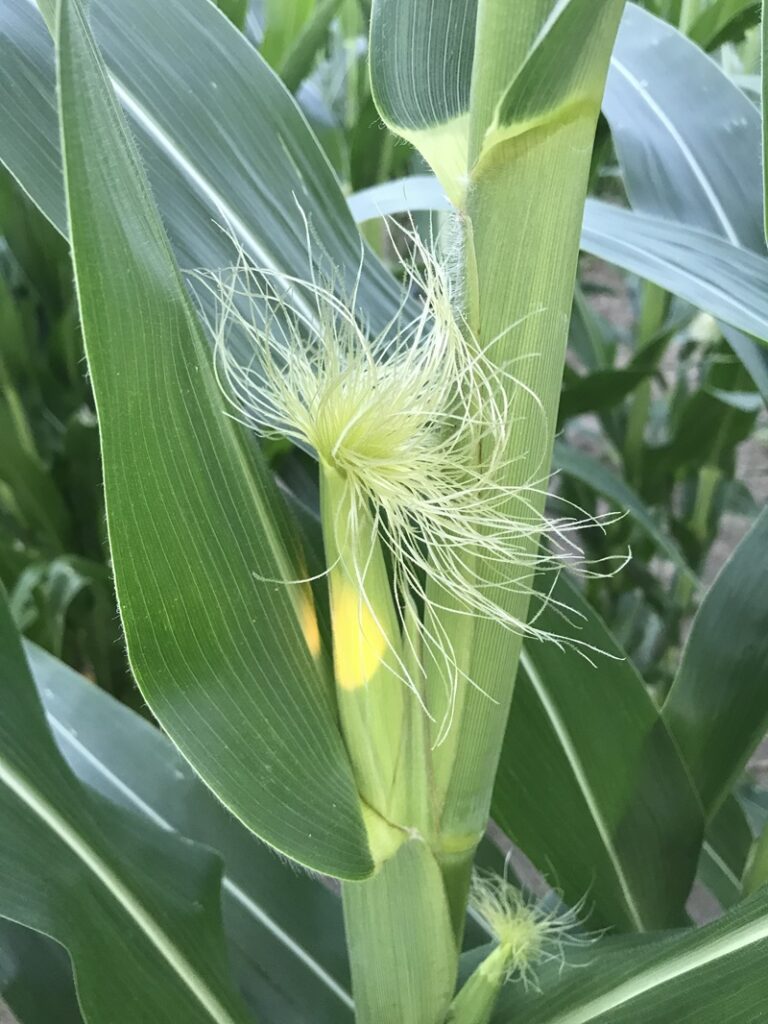
Corn development is still variable, with fields from vegetative stages to R1 (silk – one or more silks extend outside of husk leaves) appearing on the early planted crop.
Western bean cutworm (WBC) eggs have been observed in corn fields, with some WBC worms hatching and on the move. Tracey Baute, an entomologist with the Ontario Ministry of Agriculture, Food and Agribusiness, shared with Grain Farmers of Ontario that “western bean cutworm activity has increased over the last week. Moth counts are increasing, and egg masses and larvae are being found in early planted fields that are already in tassel or early silk stages. The accumulation of growing degree days is higher this year, so peak flight might occur one to two weeks earlier than normal. Earliest planted fields should be scouted first, followed by later planted fields that will just be entering the early tasselling to green silk stages when peak flight occurs. More information on western bean cutworm scouting and thresholds can be found on CropIPM.

Corn fungicide timing (depending on the protection goal and product) is occurring. Many different ear disease infections can occur at silking time, as silking is the time when the ear is exposed to pathogens such as Fusarium and Gibberella. Depending on weather conditions and the spores in each field, ear disease development begins at the pollination stage. Infections can also occur due to other ear damage from insects, animals, or hail. Which ear disease takes hold will depend on what spores are in the field and what weather conditions are ideal for those spores during and after infection. It is all about timing.
With recent conditions, Gibberella ear rot could be a concern. Check the susceptibility of each hybrid and manage accordingly for Gibberella ear rot and DON. GoCrops.ca shares the 2023 Ontario Corn Hybrid Screening Trials Report; this report gives an indication of the susceptibility of corn hybrids to DON infection. The Ontario Crop Protection Hub is a great reference for herbicides, fungicides, and insecticides registered in Ontario. Always wear PPE and follow the label. Spraying at silking, when silks have fully emerged, are green, and are not dried up, is recommended to manage Gibberella best, as silk channel infection can occur two to six days after silking, with symptoms appearing two to three weeks after infection. Be sure to scout fields, as this year, some tassel emergence is being delayed while the silk is present. Don’t just rely on the drive-by scouting method, which might not share the true staging story.
Be sure to scout for tar spot. It was found and confirmed in Ontario earlier this month and has now been identified in Essex, Chatham-Kent, Middlesex, Elgin, Waterloo and Haldimand-Norfolk. Tar spot was discovered in the province in 2020 and moved as far east as the Simcoe and Durham regions in 2021. Ideal conditions for development are when plants have over seven hours of leaf wetness. Much of the province has been experiencing this ideal condition; however, at this point, earlier planted fields are at the highest risk for development due to the larger canopy, along with fields that had the disease last year. Scouting fields is the only sure way to confirm disease infection, but the Tarspotter app can aid in identifying risk levels based on weather forecasts. Read the Grain Farmers of Ontario Agronomy Alert to learn more about this disease. The Ontario Crop Protection Hub indicates fungicides that have activity to help control tar spot. Timing of application is important if spraying when the silks are still green; also, consider the risk of Gibberella ear rot, as it will produce the DON mycotoxin. If spray timing is at the green silk stage, a tank mix with a product that also controls Gibberella ear rot should be considered (R1). For more information on tar spot, view the past GrainTalk Webinar with Albert Tenuta and this Crop Protection Network Webinar.
Northern corn leaf blight is beginning to show, with an increase in severity and incidence across the province. This increase is due to several factors, such as more corn on corn production, more corn residues (due to an increase in no-till or reduced tillage), intensive corn management strategies, favourable environmental conditions, and the development of new northern corn leaf blight races that resistance genes are not controlling. This Field Crop New article has more information on Northern corn leaf blight.
Common rust in corn has arrived in fields. It is rarely a large concern, but it is good to be aware of what is showing up in fields.
Soybeans
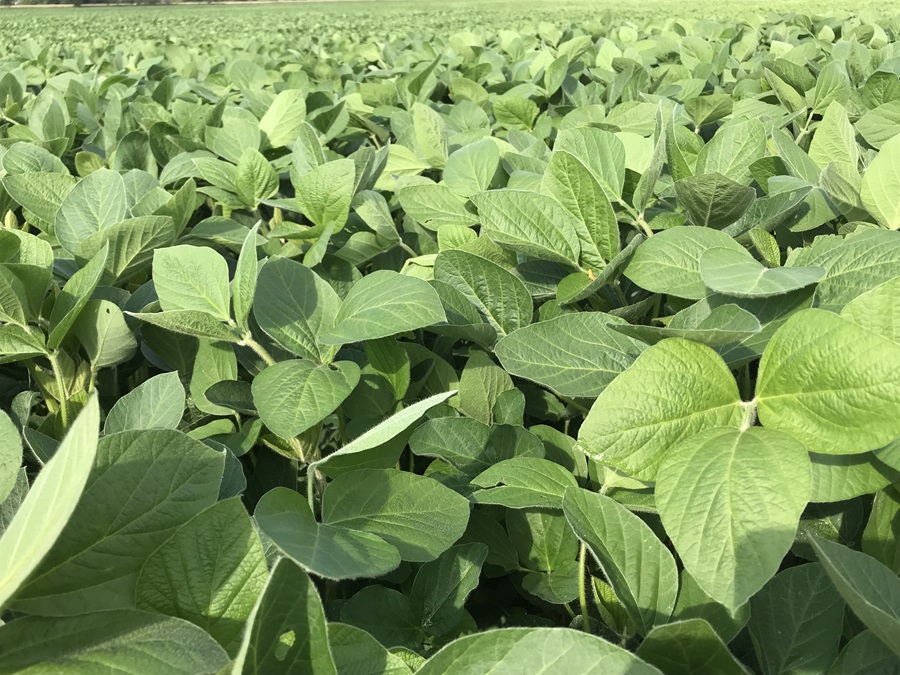
Soybeans are anywhere from the V4 (late planted) to R4 stage (full pod- pods are ¾” long at one of the four uppermost nodes on the main stem). Overall, fields are looking variable.
Fungicide timing is occurring or approaching for white mould control. The key to getting the most benefit out of fungicide applications is timing. Risks for white mould include the field history. If there is a known history of white mould, then the chance of it reoccurring is higher. Variety, row spacing, plant density, and how quickly the field will canopy all factor into the likelihood of infection. Weather patterns will also help determine the risk. When it is foggy/humid, and moisture is on the plant most of the day, there will be a higher risk of white mould. The Sporecaster App can help determine a field’s risk level. Fungicides can lower the severity of infection; however, timing is critical. The application timing ranges from R1 (single flower on the main stem) to R3 (pod on the main stem). Be sure to speak with your agronomist for optimum timing and product selection, and always follow label recommendations. Learn more about this disease in the Grain Farmers of Ontario White Mould Factsheet.
Pockets of aphids are showing up in regions of Ontario. When scouting for aphids, a threshold that should be looked for before spraying is that 80 per cent of the plants in the field have at least 250 aphids per plant with an increasing population. Scouting should occur multiple times over a period before an insecticide application is warranted to ensure an increasing population. The Aphid Advisor App is a great resource to help make decisions.
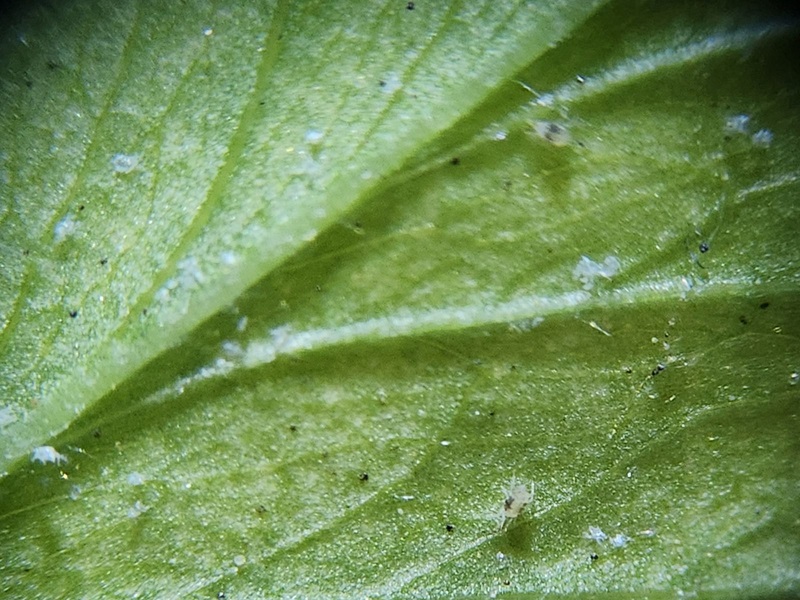
Tracey Baute, OMAFA, also shares that “two-spotted spider mite (TSSM) infestations are showing up in a few soybean fields, despite the wet weather. So far, reports have come from south of Cambridge, but more sightings are expected in the next week or two, given that the wheat harvest is underway and hot temperatures continue. Over the last three years, more than half of the soybean fields tested have had dimethoate-resistant TSSM populations. This year, we are looking for more samples to test for resistance at Western University as part of a Grain Farmers of Ontario-funded project. Anyone finding populations before or after a dimethoate application in soybeans or dry beans should contact Tracey Baute to collect samples for testing. Past results can be found in this Ontario Crop Report from last year”.
Cereals
As some areas are winding down from winter wheat harvest, others are just getting started, with most of the province now having completed or currently harvesting winter wheat. Wheat harvest is progressing across the province as weather allows, with about 50 percent complete.
Weeds
Have there been some tough-to-control weeds this year? Tough to control weeds might partly be due to the size of the weeds when the sprayer finally got into the field (due to wet conditions) or due to poor crop stands allowing for late season emergence of weeds. But some might be due to resistance.
Be sure to scout for Waterhemp, which is resistant to multiple herbicide groups in various regions of the province. And a new weed that was identified last year, Palmer Amaranth, which is highly competitive, can spread easily, and has known herbicide resistance to 9 different herbicide groups. If you think that there might be a Palmer Amaranth plant in your field, contact Mike Cowbrough, OMAFA.
July 18, 2024
More rain has hampered the winter wheat harvest, with some areas receiving upwards of four inches of rain earlier this week. Corn and soybeans are still developing well through vegetative and reproductive growth stages; disease infection is a concern with the high moisture environment.
Corn
Corn across the province is staging from the vegetative stages into reproductive stages (VT-tassel and R1-silk, in earlier planted fields). As corn nears the end of the vegetative stage it is finalizing the number of potential kernels. Under severe stress, kernel numbers will be reduced. Lack of moisture at pollination timing can reduce the pollination potential and lack of kernel development; so far this year, there have been few moisture-limiting concerns, more like excessive amounts of moisture, but this can change quickly. Saturated soils have kept roots at a shallow depth within the soil, which can cause concerns such as root lodging in saturated soils, a lack of nutrient availability with shallow roots, and if soils dry up, the root capacity is not there to scavenge for deeper water, as it might have been if it were a drier spring.
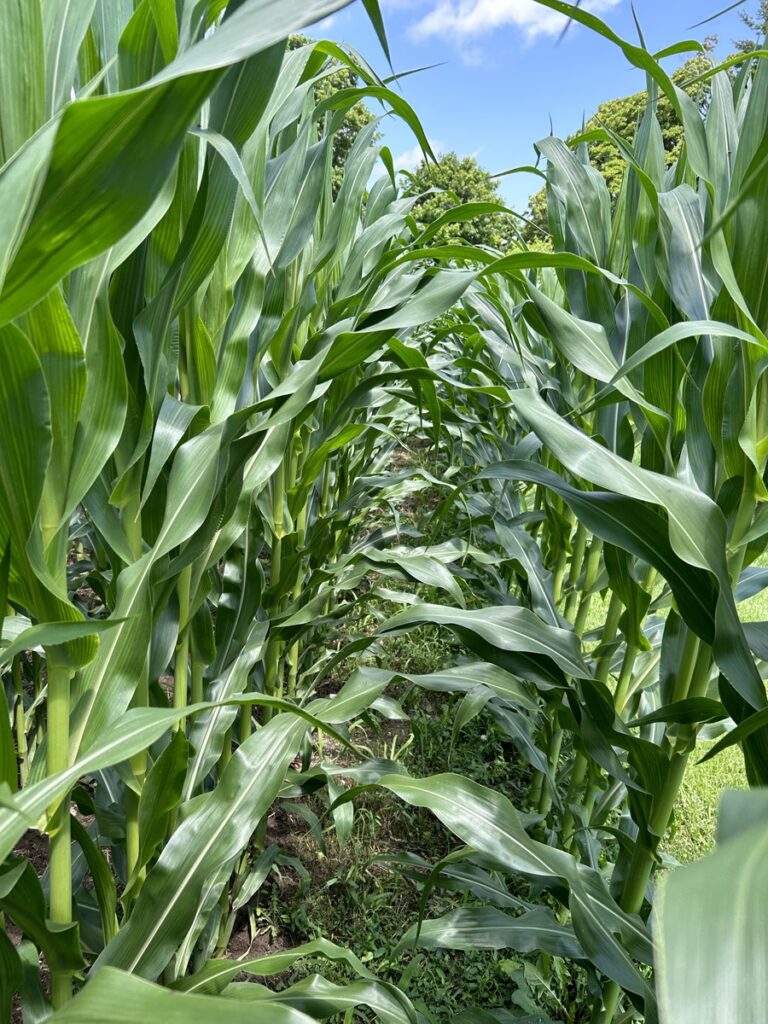
Gibberella ear rot infections occur with warm (27 °C), humid temperatures and rainfall that splashes fungal spores onto corn silks two to six days after silk emergence. With recent conditions, Gibberella ear rot could be a concern. Check the susceptibility of each hybrid and manage accordingly for Gibberella ear rot and DON. GoCrops.ca shares the 2023 Ontario Corn Hybrid Screening Trials Report; this report gives an indication of the susceptibility of corn hybrids to DON infection. The Ontario Crop Protection Hub is a great reference for herbicides, fungicides, and insecticides registered in Ontario. Always wear PPE and follow the label. Spraying at silking, when silks have fully emerged and are not dried up, is recommended to manage Gibberella best, as silk channel infection can occur two to six days after silking, with symptoms appearing two to three weeks after infection.
Be sure to scout for tar spot. It was found and confirmed in Ontario earlier this month. Tar spot was discovered in the province in 2020 and has moved as far east as the Simcoe and Durham regions in 2021. Ideal conditions for development are when plants have over seven hours of leaf wetness. Much of the province has been experiencing this ideal condition; however, at this point, earlier planted fields are at the highest risk for development due to the larger canopy, along with fields that had the disease last year. Scouting fields is the only sure way to confirm disease infection, but the Tarspotter app can aid in identifying risk levels based on weather forecasts. Read the Grain Farmers of Ontario Agronomy Alert to learn more about this disease. The Ontario Crop Protection Hub indicates fungicides that have activity to help control tar spot. Timing of application is important if spraying when the silks are still green; also, consider the risk of Gibberella ear rot, as it will produce the DON mycotoxin. If spray timing is at the green silk stage, a tank mix with a product that also controls Gibberella ear rot should be considered (R1). For more information on tar spot, view the past GrainTalk Webinar with Albert Tenuta and this Crop Protection Network Webinar.
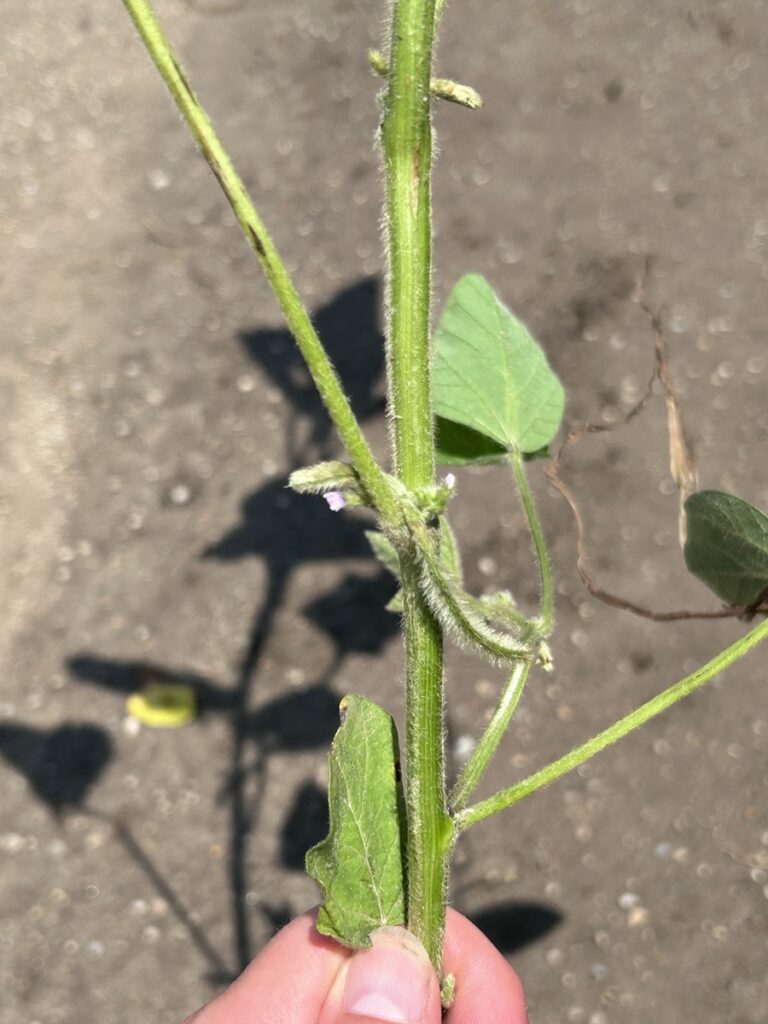
With a wide range of maturities and planting dates, it will be imperative to know the stage of each field to apply fungicides at the right time for the best control.
Soybeans
Soybean stages range from still in vegetative growth to R3 (early pod development – when there is a pod at least 3/16 inch long (but less than 3/4 inch long) at one of the four uppermost nodes on the main stem with a fully developed leaf. Soybean plants will usually flower over 25 to 35 days, with flowering still occurring as pods develop.
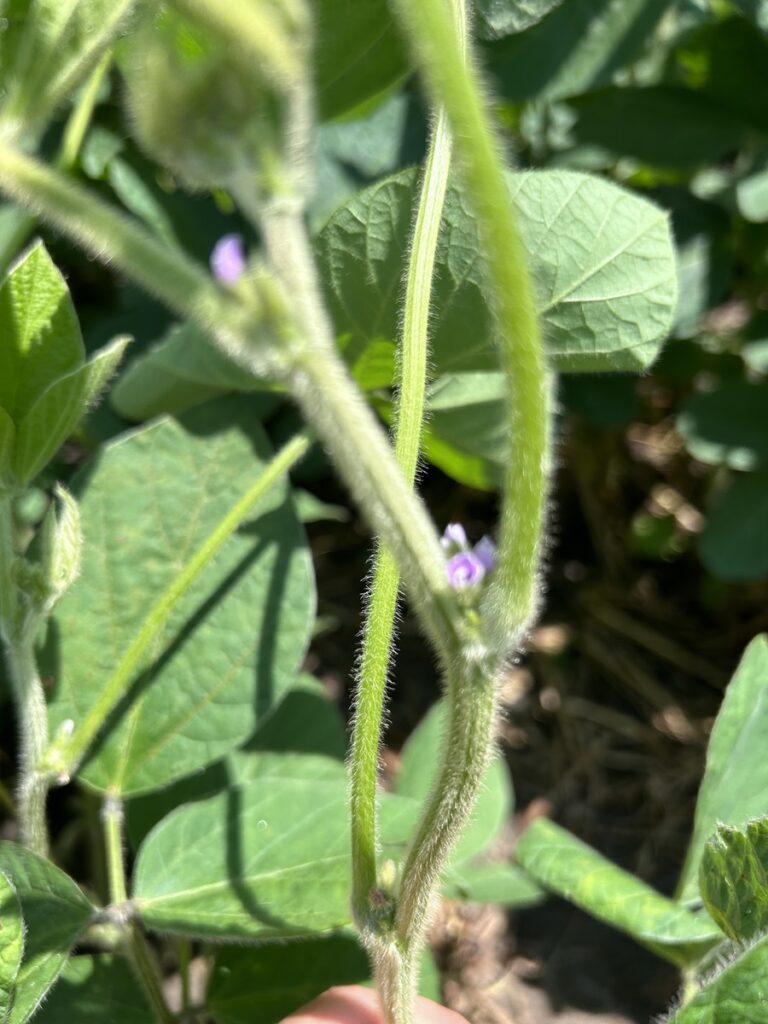
With a high amount of moisture being received while soybeans are flowering, they should be on the defensive against white mould. The ideal timing for fungicide applications is between the R1 and R3 stages when the infection is occurring. Some may choose one pass of fungicide (approximately 15 days after flowering begins), while others might choose two passes of fungicide (first pass when the majority of the plants have a single flower, coming back through eight to 10 days after so that both passes are applied during peak flowering period. More information on white mould can be found in the Grain Farmers of Ontario Factsheet.
For more information on white mould and other diseases to watch for in soybeans, view the GrainTalk Webinar with Albert Tenuta.
Cereals
Winter wheat harvest has been stop-and-go for regions with grain ready for the combine, with an anticipated around 25 per cent complete. Some limitations to harvest have been overcast skies, heavy dews, and rain showers not allowing the plant to dry. When combines are rolling, moistures are anywhere from 12 to 18 percent, with reports of decent test weight (fields lodged during grain fill show lower test weights; harvest delays and wet conditions can also affect test weight).
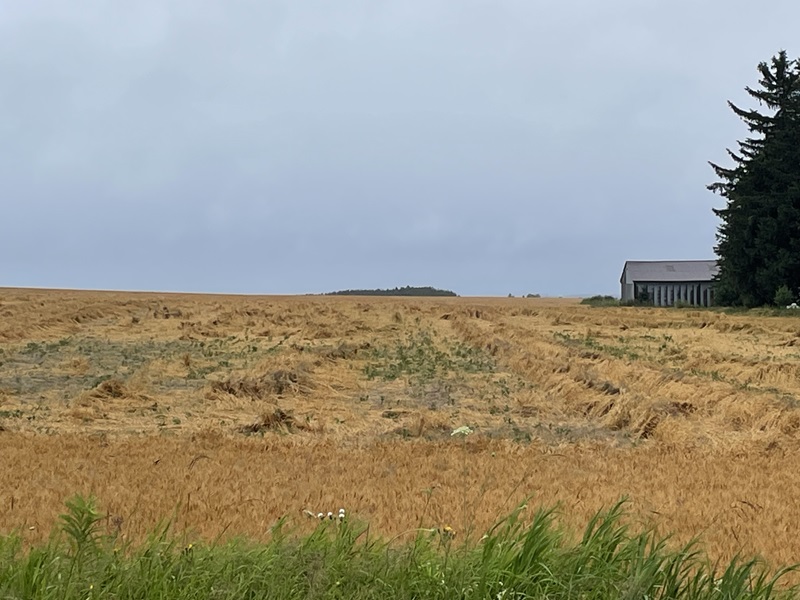
With heavy rains and strong winds that moved through the province, some fields have been lodged. Lodging certainly makes harvesting an adventure, but it can also lead to disease development. When a plant is lying on the ground, it remains wetter for longer than if it were standing up, increasing disease. If a field is mature, aim to harvest the lodged fields first to limit disease incidence.
Black point (a black smudging of discoloration on kernels or a black cloud of spores floating around the combine at harvest) could be of slight concern as the disease develops when it is wet and warm during the grain fill and ripening period. More can be learned at the 23:24 minute mark on this Grain Farmers of Ontario GrainTalk Webinar.
Oats and barley are in the midst of grain fill.
July 11, 2024
This week, the winter wheat harvest continues. Corn is well over waist high in some areas, with tassels beginning to emerge on early planted corn. Note that the first report of tar spot was reported in Ontario this past week. Soybeans are steadily growing vegetatively, with many moving into reproductive stages. Scattered showers have kept fields well-saturated in a number of regions.
Corn
Early planted corn is nearing the end of the vegetative stage, and the number of potential kernels is finalizing. Under severe stress, kernel numbers will be reduced. We will start seeing tassel emergence in the earlier planted fields shortly. When the last branch of the tassel emerges from the whorl, we will reach the VT stage. (VT is for the vegetative tassel stage.)
Tar spot was confirmed in Ontario on July 5 in Elgin County. This is similar to other years, with ideal canopy and environmental conditions for this time of year. Current Tar Spot infections will occur in fields with a history of tar spot and those with a larger canopy, like the earlier planted crop, as the conditions of the larger canopy are ideal for disease development. Late planted corn that has not canopied yet or wide rows and small corn would not be a concern until the crop reaches the V8 to VT timing as the canopy is large enough to be conducive to infection. These late fields may miss the early calendar date but may still be impacted as the disease develops this summer. Scouting fields is the only sure way to confirm disease infection, but apps like Tarspotter can aid in identifying risk levels based on weather forecasts. This disease is now endemic in western Ontario as we have had several years of infection, and the disease overwinters in soils. The disease infection will start lower in the canopy if the disease infection is from spores within the field.
Adjacent U.S. states, Michigan and Indiana, are also reporting tar spot infections. This indicates that more spore development is occurring sooner this year, which can lead to future infections in our fields as the spores are released and wind patterns move spores into unaffected areas. The airborne spores will infect the top of the canopy.
Scouting and identifying the location of the disease in the canopy helps to indicate if the field was self-infected or if the infection was airborne. Either way, you have the disease, and the earlier you can treat the crop, the more leaf tissue and plant health you can preserve to maintain your yield potential. Timing is important as most fungicides are good only for +/- 14 days. The sooner you spray, and if the growth stage is early, the more likely you will need a second spray if conditions are favourable for the disease. Select fungicides that control tar spot, as not all fungicide products control tar spot. If you are spraying when the silks are still green, consider your risk of gibberella ear rot, as it will produce DON mycotoxin. A tank mix with a product that also controls gibberella ear rot should be considered if your spray timing is at the green silk stage (R1). There will be more about that in the coming weeks.
Soybeans
Soybean stages range from still in vegetative growth to R2 (full bloom). At R2, plants have an open flower at one of the two uppermost nodes on the main stem. From R2 to R4, the soybeans are rapidly uptaking water and nutrients (with uptake peaking at R4). It is important to keep soybeans healthy for optimum yield.
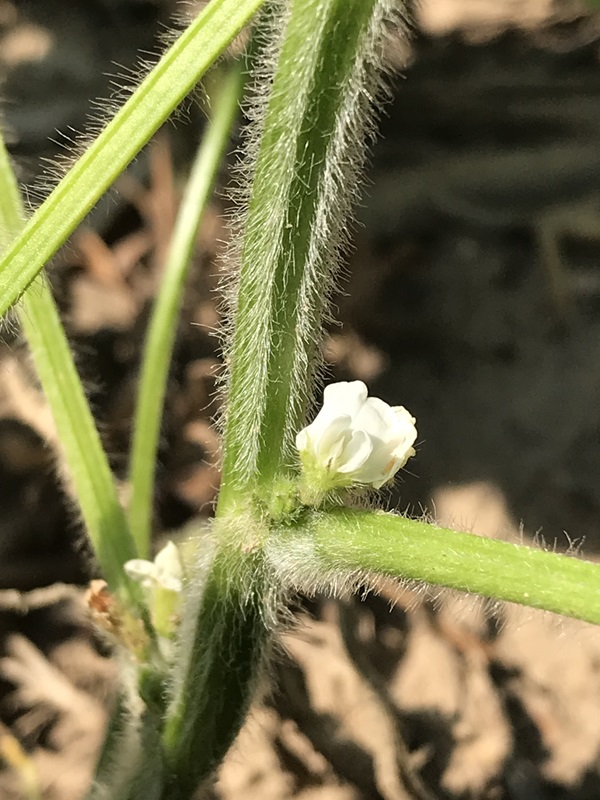
Watch for diseases like white mould and insects like aphids (see further info in last week’s field observations).
The Ontario Crop Protection Hub is a great reference for herbicides, fungicides, and insecticides registered in Ontario. Always wear PPE and follow the label.
Double-crop soybeans are being planted after winter wheat when possible. More information on double cropping soybeans and things to consider when double cropping can be found in last week’s field observations.
Cereals
Winter wheat harvest has continued, as weather allows. Harvest was wrapping up in the deep southwest region before tropical storm Beryl hit, while the rest of the province is gearing up to make a major move on harvest after we dry up from Beryl. Harvest in the province would be approximately 10 to 20 per cent complete province-wide. So far, wheat is coming off close to dry in the 16 to 13 percent range , with average yields and good quality
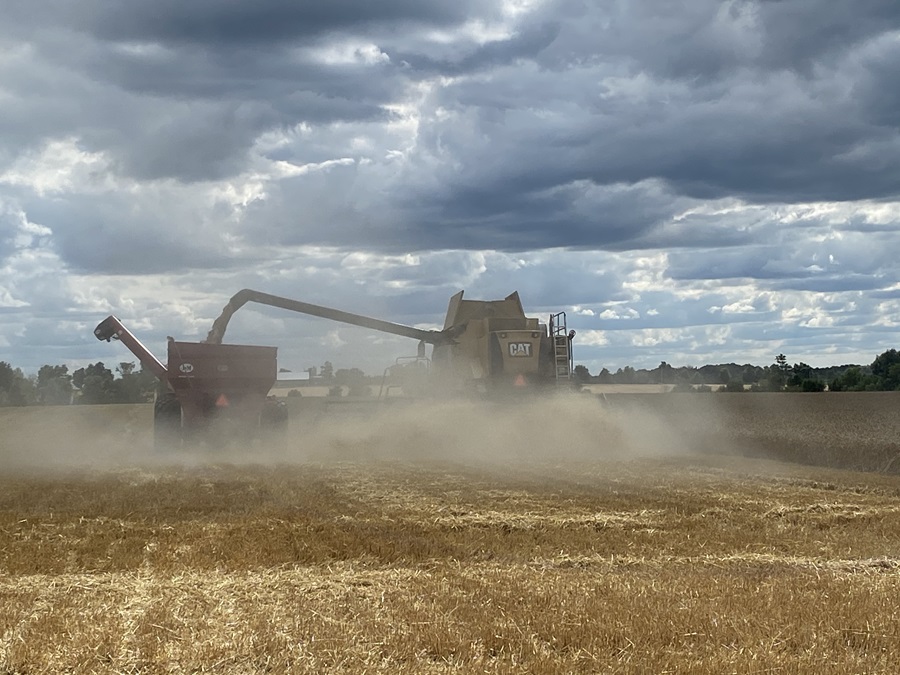
As the harvest progresses and moves across the province, keeping an eye out for Fusarium is imperative. Using a visual scale to estimate the severity of Fusarium across fields can help target which fields to harvest first. The aim would be to harvest the fields with the highest severity first, as DON levels can almost double each time a storm rolls through. When harvesting, aim to set the combine to blow out Fusarium-damaged kernels (if the moisture is higher, this may be more challenging). Some key tips to do this are in the link above. Note that lodged wheat has an increased potential for Fusarium infection and DON production. More can be found here.
Another concern on farmers’ minds is the chance of sprouting with the continuation of scattered rain showers.
The winter barley harvest is wrapping up.
Spring cereals are closing in on the boot-to-head stages.
Northern Ontario has also been experiencing high volumes of rain, which has crops developing well, although there have been excessive moisture challenges like most of the province.
July 4, 2024
Plenty of moisture over the past week (up to 4 inches in some areas) has, again, caused saturated soils. Crops continue to progress well in most areas (corn staging up to V11 and soybeans up to R1) with somewhat limited disease or insect pressure (crop area dependent) as of yet. With increased moisture in soils and from the sky, there is an increased chance of disease. The winter wheat harvest has begun and will continue until complete, as weather allows.
Corn

The corn crop is developing nicely as we move into the summer months. Corn is staging between V5- V11 (six to 12 leaves). Around V5, the growing point is now above the soil surface. At V9, the tassel is rapidly developing but is not yet visible at the top of the plant. New leaves appear every 2 to 3 days, and ear shoots are also developing.
Some Nitrogen is still being side-dressed.
Tar spot has been identified this summer in the southern part of Michigan. Should conditions warrant, be prepared to apply a fungicide that controls tar spot when the forecasted risk level is high (favourable weather) and where disease has been identified in the local area in previous years. The Tarspotter app can give a good indication of risk, with the optimum time to run the app between V10 to R3. It is best to manage tar spot during corn growth stages V8 to R4; always read and follow labels and speak to a local agronomist to make a spray decision.
Soybeans
With the soybean planting date being extended by Agricorp to July 2, some soybeans were still going into the ground this past weekend (where weather permitted). With that, stages for soybeans are anywhere between VE (emergence) and R1 (beginning bloom – at least one flower appears on the plant on any node on the main stem). Staging is important as the season progresses to be able to apply herbicides, fungicides, and insecticides safely and effectively as required.
Fields are looking a bit stressed in some areas from saturated soils. In some fields, nodulation is not occurring yet, and soils are denitrified from prolonged ponding. Symptoms of yellow and stunted plants can be seen between tile runs or in lower areas with heavier soils. As the plant reaches the V2 to V3 stage, nitrogen fixation begins; however, saturated soils have an impact on nitrogen fixation due to the processes (and the associated bacteria) needing gas exchange for the activity.
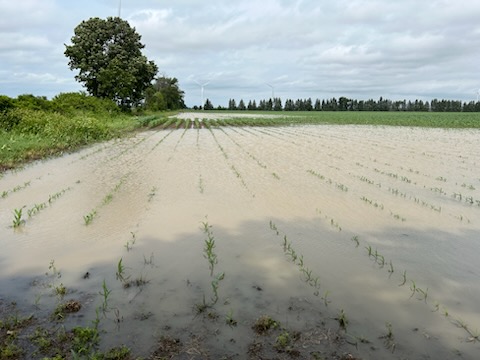
Root and stem rots can also be common in soils that have excess moisture.
Keep an eye out for Soybean Cyst Nematode damage as the season progresses. At high populations nematodes can cause yellowing of leaves, stunting and early maturity, often in circular shaped patterns. SCN can be tested for and should be monitored for every three to six years; more info can be found here.
Fungicide timing is occurring or approaching for white mould control (find out more about white mould). The key to getting the most benefit out of fungicide applications is timing. Risks for white mould include the field history. If there is a known history of white mould, then the chance of it reoccurring is high. Variety, row spacing, plant density, and how quickly the field will canopy all factor into the likelihood of infection. Weather patterns will also help determine the risk. When it is foggy/humid, and moisture is on the plant most of the day, there will be a higher risk of white mould. The Sporecaster App can help you determine your field’s risk level. Fungicides can lower the severity of infection; however, timing is critical. The application timing ranges from R1 (single flower on the main stem) to R3 (pod on the main stem). Be sure to speak with your agronomist for optimum timing and product selection, and always follow label recommendations.
There have been some reports of aphids. When scouting for aphids, a threshold that should be looked for before spraying is that 80 per cent of the plants in the field have at least 250 aphids per plant with an increasing population. Scouting should occur multiple times over a period of time before an insecticide application is warranted to ensure an increasing population. The Aphid Advisor App is a great resource to help make decisions.
A reminder as the season progresses that Grain Farmers has supported the development with OMAFRA of the Pest Manager app, which allows you to identify, map, and find integrated management options for common weeds, insects, and diseases in corn, soybeans, and cereal crops. The pesticide use information in the app is specific to Ontario, and users should always read the product label before use.
Cereals
Winter wheat is staging from GS 85 (soft dough) to fields harvested. Harvest for many areas is about one week earlier than normal.
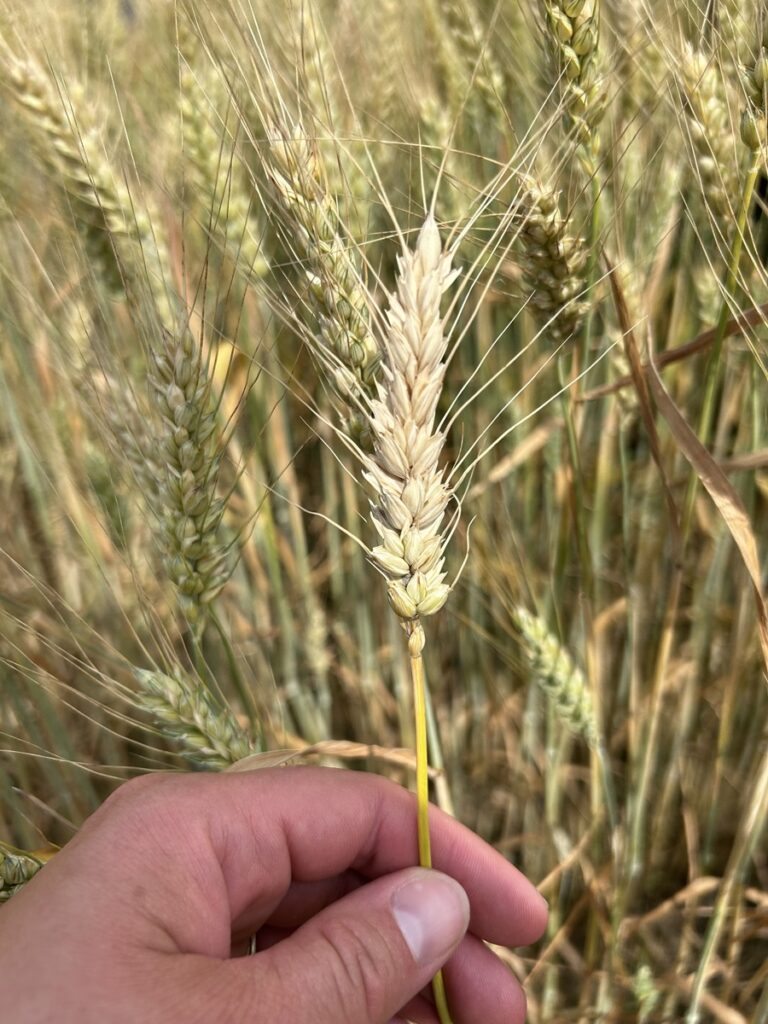
The maturity of wheat can be determined by the peduncle changing from green to yellow. At this point, the crop is fully mature, grain fill, and the translocation of plant sugars has been completed (this stage can be compared to the black layer on corn). It takes roughly 660 growing degree days (GDD) to fill a wheat head. This period of GDD spans approximately 25 to 30 days for grain fill (less if it is extremely warm) – not a very long time.
Winter wheat harvest has begun, as weather has allowed, in the deep southwest region of the province. As harvest continues, scout for fusarium-damaged heads in the field. Infected fields should be harvested first to limit continual toxin build-up in case of rain events or delayed harvest. Set the combine correctly to help blow out the lighter infected kernels. Fusarium is showing up at low levels, sometimes only infecting a few florets on a few plants within a field (this might be due to T3 fungicides being applied at ideal timing for the majority of the field, but some tillers might have pollinated slightly behind the majority of the field). The incidence of fusarium infections has been reduced over the past 20 years due to genetic improvements and the use of fungicides during pollination (T3 timing) to help control fusarium. This spring, a larger amount of the winter wheat crop was exposed to ideal conditions (think of the disease triangle for fusarium infection: susceptible host + pathogen + favourable environment), but farmer practices have helped to manage the incidence of infection.
If winter wheat is harvested and reductions in yield and quality due to high fusarium levels are experienced, be sure to contact Agricorp.
With lots of moisture and lodged wheat, there could also be a concern about sprouting. Keep an eye out for sprouts and harvest early. Review any delivery contracts and look for the specification of the grain required for delivery against the contract. Ship grain that meets the required specifications that are signed off on. The most notorious inclusion on contracts is the base falling number requirement that can be caused by rainy weather and sprouting or caused by high alpha amylase expression in the grain due to cold stress during grain fill.
With the early wheat harvest, double-crop soybeans are a common conversation in some areas. If aiming for double-crop soybeans, seed supply on early-season beans will be needed. The date of wheat harvest and the field location will determine a lot. Aim for seed maturity that is at least one full maturity group shorter, but check with your seed dealer about what they suggest and what is available. The seeding rate should be increased to at least a population of 250,000 seeds per acre. The planting date should be considered, looking at frost dates, as the yield potential will drop considerably if soybeans are planted too late. Early to mid-July planting dates are ideal, be sure that the soybeans are going into good conditions. The ideal planting dates for double-crop soybeans would be before July 10 in southwestern Ontario and before July 20 in the deep southwest, but there is a large risk at any date; the soybeans might yield or not. Managing straw is critical; be sure to spread straw and chaff evenly. If you are considering baling, realize that the time spent baling might keep you out of the field planting for a couple of days. If you plan to double-crop soybeans, plant to moisture – up to 3” in July as they will push through. If there is no moisture at that level, aim for 1” planting depth and hope for rain.
The need for weed control in double-crop soybeans will be less – in theory, one pass would still be needed to control weeds. Most annual weeds emerge during May and June, and if double-crop soybeans are planted in July, weed pressure should be considerably less. Limit the investment in weed control as the chance for good soybeans is less likely, with much relying on the weather cooperating for a good yield and harvest so late in the season.
4R and soil sampling
As winter wheat is harvested, it makes for a great time to get some soil samples complete in an effort to ensure that the right rate of fertilizer is being applied at the right time, in the right form, and in the right place.
Cover Crops
Cover crops have an important role in maintaining soil productivity and quality. After cereal crops are harvested, it can be an ideal time to plant cover crops. The Cover Crop Selector Tool uses Ontario-based research (supported by Grain Farmers of Ontario) to help farmers select the best cover crops and provide management support, like planting population, for their operation.
June 27, 2024
The first few days of the summer season were warm, leading to rapid crop development and crop heat unit (CHU) accumulation. From June 17 to June 23, 2024, in Elora, 206 CHUs were accumulated compared to the 54-year average of 176; other areas of the province are also showing greater than average accumulations, as can be expected with temperatures exceeding 35 degrees Celsius.
Corn and soybean development continues as winter wheat harvest nears for the deep southwest of the province.
Corn
With the heat last week, corn motored along, reaching knee-high well before the first of July (with some corn at waist-high), with others close behind. There is still a high degree of variability in crop staging across the province from V1 to V9 (8 leaf). Side dressing is occurring.
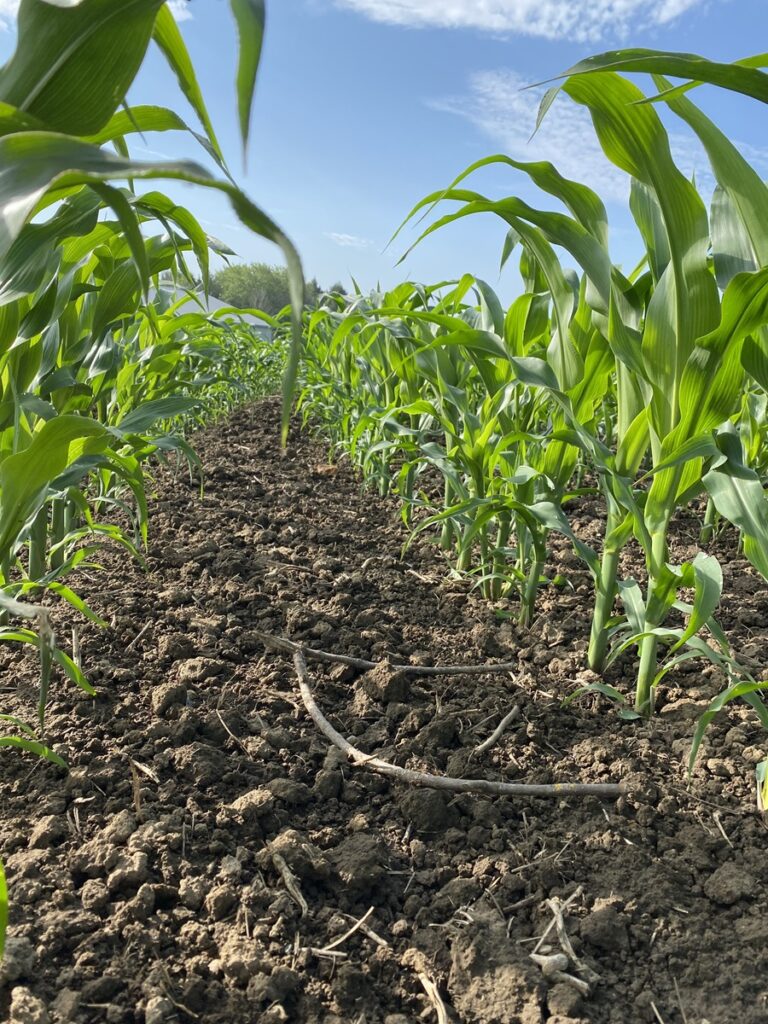
At about the V6 stage (six collars, or 8 leaf stage), the growing point emerges above ground level. The critical stage of ear development is from this stage to about a week before pollination. Ear initiation starts, and then the kernel rows per ear are determined. The number of kernels per row is determined as the ear elongates and is determined before pollination. Stress in the upcoming weeks from lack of nutrients or moisture will reduce grain potential through reduced kernel numbers. Stress can be caused by many factors like too high a population, weed pressure, root pruning from machines or insects, lack of fertility, lack of rainfall, standing water, hail damage, disease, etc.
Rapid growth syndrome has been and can be seen in fields with changes from cool to high heat. It occurs when corn leaves do not unfurl properly, and the whorl becomes tightly wrapped and twisted.
As fungicide timing approaches, be aware of the potential for Tar spot and Gibberella ear rot (which can cause DON in corn). The Ontario Corn Committee has posted the 2023 Ontario Corn Hybrid DON Screening Trials. These trials may be helpful in determining how susceptible hybrids are to Gibberella ear rot and DON accumulation—use them as a tool as fungicide spraying approaches.
Soybeans
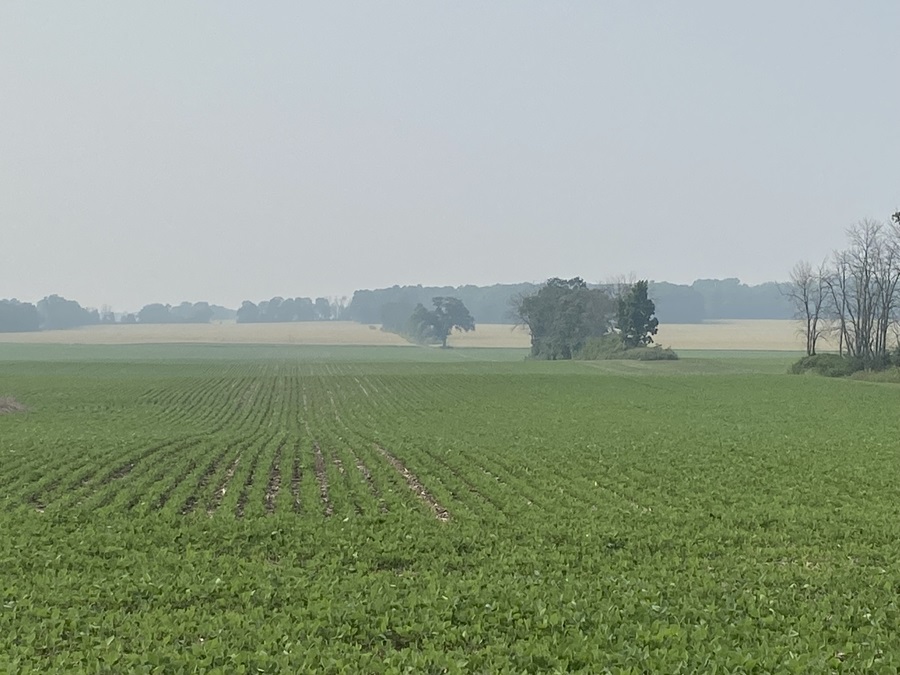
Soybean fields are staging from the VE (emergence) up to beginning bloom (R1—plants have at least one flower at any node). Soybean planting is still occurring in areas that struggled to plant earlier this year, and some replants are also occurring.
In the V3 to V5 stages, axillary buds develop into flower clusters near the top of the stem. In the coming days, flowering will begin, starting on the 3rd to 6th nodes and continuing down the stem. At this point, the plant will transition into reproductive stages (R1) while continuing to grow vegetatively.
As resprays occur, be sure to mitigate drift. Both BeDriftAware.ca and the recent Grain Farmers of Ontario GrainTalk webinar with Dr. Jason Deveau have valuable tips when spraying to help mitigate drift.
Agricorp planting deadlines and reporting of final acres for soybeans are all due on June 30.
Cereals

Winter wheat harvest will begin gearing up in the coming days in the deep southwest. As harvest approaches, scout for fusarium-damaged heads in the field. Infected fields should be harvested first to limit continual toxin build-up in case of rain events or delayed harvest. Set the combine correctly to help blow out the lighter infected kernels. Fusarium is showing up at very low levels, sometimes only infecting a few florets on a few plants within a field (this might be due to T3 fungicides being applied at ideal timing for the majority of the field, but some tillers might have pollinated slightly the majority of the field). The incidence of fusarium infections has been reduced over the past 20 years due to genetic improvements and the use of fungicides during pollination (T3 timing) to help control fusarium. This spring, a larger amount of the winter wheat crop was exposed to ideal conditions (think of the disease triangle for fusarium infection: susceptible host + pathogen + favourable environment), but farmer practices have helped to reduce the chance of infection.
Across much of the province, kernel fill is still occurring in the winter wheat crop (GS 73 to GS 87 hard dough/physiological maturity). Prolonged hot, dry weather will limit kernel fill resulting in smaller kernels as the water availability for the crop becomes limited. Kernel abortion and dead heads can be seen as the plant dies rather than matures if moisture becomes too limited during this period (during the hot, dry period of last week this was seen occurring on sandy knolls within fields).
It is imperative to ensure that treated seed does not make its way into grain at harvest. As planting wraps up and harvest nears, ensure that equipment that handled treated seed is ready to handle grain (and cleaned out using proper protocols), with no contamination. Grains or oilseeds contaminated with treated seed or other foreign material put domestic and export markets at risk. Learn more in the Grain Farmers of Ontario Handling treated seed Fact Sheet.
June 20, 2024
There are variable-looking crops, both in stage and appearance, across the province as spring rolls into summer this week. Corn planting has wrapped up, while soybean planting is still progressing. Winter wheat is staging from milk to dough stage, and winter barley harvest is beginning. Heavy rains from pop-up storms have caused some temporary ponding in fields (and possible crusting in newly planted fields).
Corn
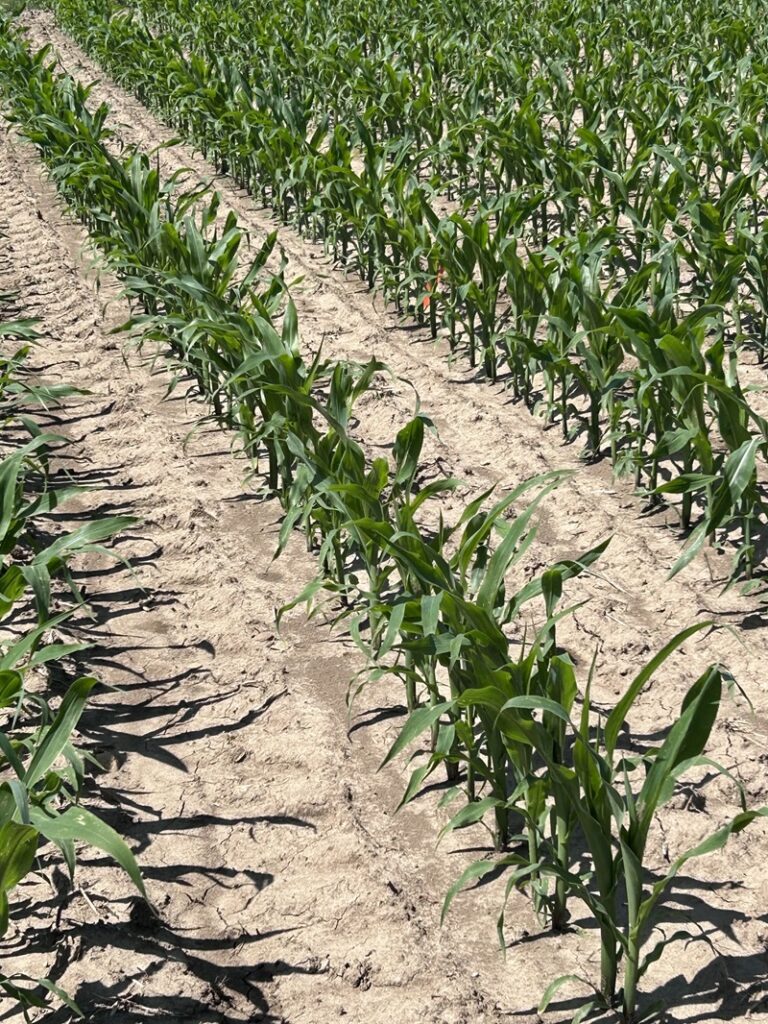
Corn planting is mostly wrapped up as the Agricorp extended deadline for insurance has come to a close; any remaining acres will now almost certainly be transitioned to soybeans. Crop development is occurring rapidly, with heat units accumulating quickly. Lots of corn is between emergence (VE) and V8 stage (9 leaf). V stage refers to the vegetative stage with the counting of collars on the corn stalk. At these early stages, side dressing occurs when field conditions allow in between rains. From V6 to V10, the corn plants will be developing the ear, and at this stage, kernel numbers per row and rows per cob will be determined. Stress in the upcoming weeks from lack of nutrients or moisture will reduce grain potential through reduced kernel numbers.
As corn plants are developing rapidly, plant variability is showing up as evidence of compaction damage from tillage or planting when conditions were too wet. This could be seen as smaller plants, discoloured as purple or yellow as root development is limiting nutrient uptake due to impacted soil.
The province has received consistent rains and rainfall up to this point, along with some ideal temperatures for tar spot development. If it does begin to develop, infection may start showing up in the first couple of weeks of July in fields that have had tar spot in previous years as spores are present locally. Check the bottom of the canopy for these local infections. There are still some variables, but if weather conditions continue with high humidity and leaf wetness, it will encourage the development of the disease. Disease progression will continue depending on the weather received and the spore load coming for infected fields; spores coming from other fields will show infection starting on the top of the canopy. For more info on tar spot and to see what to look for, read our Agronomy Alert. There have already been fields identified with Tar spot in Indiana.
Be on the lookout for black cutworm, as it can cause problems. Fields that do not have insecticide-treated seed or do not have Bt hybrids containing Cry1F or Vip3A should be given priority in scouting. Learn more about what to look for in this Field Crop News article.
Soybeans
Soybean staging is up to the 4th trifoliate in many areas, with some just emerging. Some soybeans are struggling in areas that have had very heavy rains after planting, creating crusting and causing slow emergence; planting is still occurring in some areas.
Be on the lookout for insect pressure, especially on fungicide-only or untreated soybeans.
Cereals
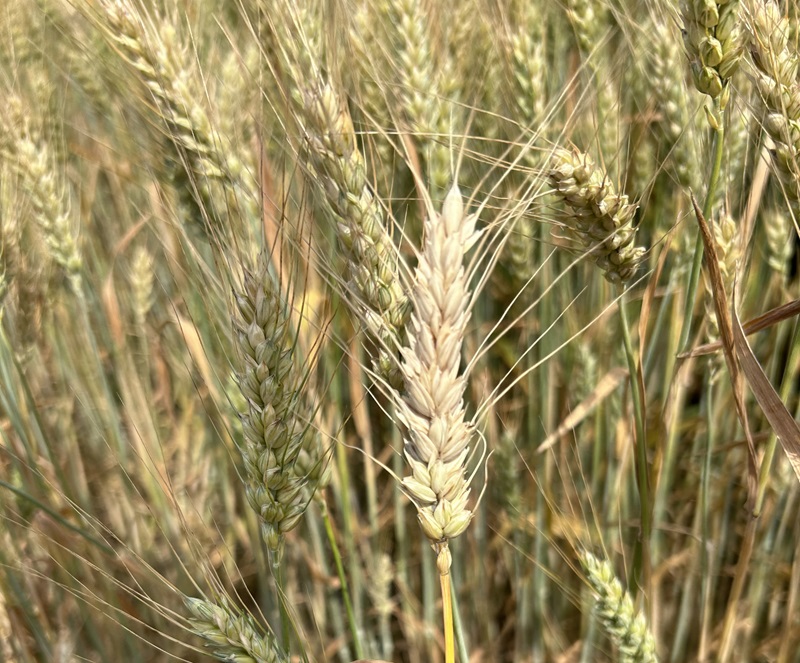
Winter barley harvest has begun.
Spring cereals are in the stem elongation stage.
For winter wheat, stages range from the milk stage (GS 71- kernel watery ripe) to dough stage (GS 87- hard dough). Standability seems good so far in most areas. However, some are seeing some lodging in fields that had high nitrogen (N) rates, in those that had received manure that is traditionally high in N, or in those that have received heavy rains.
As temperatures increase, crop development speeds up. The average temperature range of 19–22 °C is the optimum for anthesis and grain filling in wheat. The high temperatures occurring and expected will impact grain fill. High temperatures also mean high water needs. In general, much of the province has a good supply of moisture in the soil, but this may be tested in the coming days if timely rains do not occur.
Ideal conditions for DON development are also occurring; some fields that saw timely T3 applications are still showing minimum fusarium infection. This is caused by application timing and the timing difference of anthesis within the canopy. Variable field conditions also lead to different pollination timing within the canopy. Fields that are showing Fusarium infection should have the combine adjusted to blow the Fusarium-damaged kernels out the back of the combine (due to their light weight). This will help improve the grading factor.
Be on the lookout for army worm, province-wide, and be prepared to spray as warranted.
Field Crop News houses tools for corn growers
Field Crop News is now the source for the Ontario Corn Nitrogen Calculator, Ontario Corn Replant Decision Aid Tool, Optimum N-Rate Estimator, Ontario Corn Committee Hybrid Selector Tool, Ontario Manure Nutrient Calculator, and the Ontario Crop Residue Value Estimator. These tools were all previously housed on gocorn.net website (which has been replaced by GoCrops.ca).



